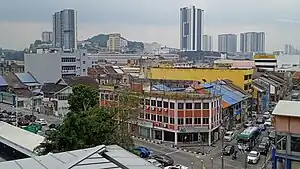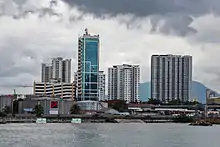George Town, Penang
George Town is the capital of the Malaysian state of Penang and the core city of the George Town Conurbation, Malaysia's second largest metropolitan area with a population of 2.83 million. The city proper covers an area of 306 km2 (118 sq mi) and was home to a population of 794,313 as of 2020.
George Town | |
|---|---|
| City of Penang Island Bandaraya Pulau Pinang | |
| Other transcription(s) | |
| • Jawi | جورج تاون |
| • Mandarin | 乔治市 (Simplified) 喬治市 (Traditional) Qiáozhì shì (Hanyu Pinyin) |
| • Hokkien | 坡底 / 喬治市 Pho-té / Kiâu-tī-tshī (Tâi-lô) |
| • Tamil | ஜார்ஜ் டவுன் Cārc Iḍavuṉ (Transliteration) |
From top, left to right:
| |
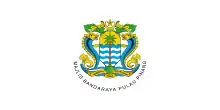 Flag  Coat of arms | |
| Etymology: George III, King of Great Britain and Ireland | |
| Nickname(s): | |
| Motto(s): Leading We Serve (Malay: Memimpin Sambil Berkhidmat) | |
OpenStreetMap Location of George Town in Penang | |
 George Town 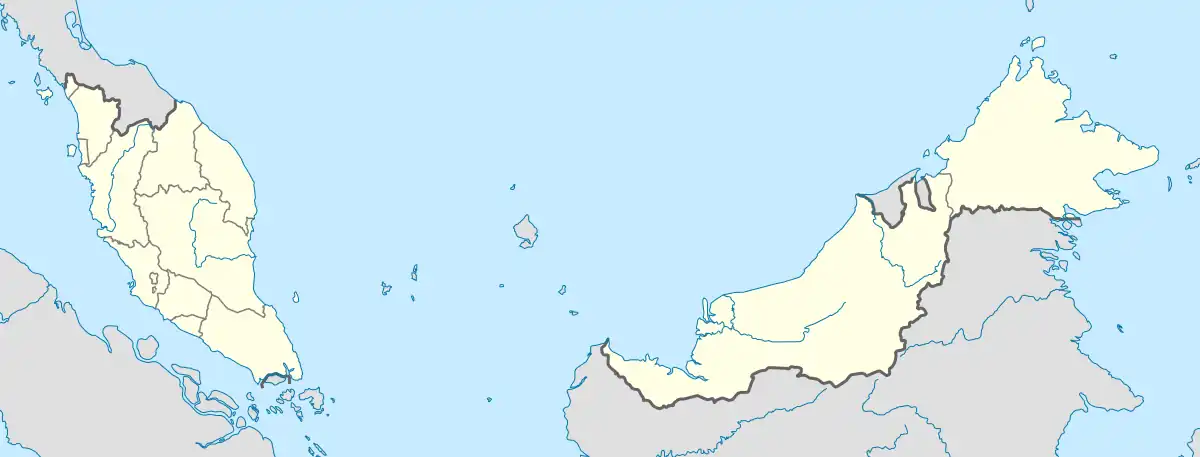 George Town George Town (Malaysia)  George Town George Town (Asia) .svg.png.webp) George Town George Town (Earth) | |
| Coordinates: 05°24′52″N 100°19′45″E | |
| Country | |
| State | |
| Districts | Northeast and Southwest |
| Mukims | City Centre and 38 sub-districts |
| Founded | 11 August 1786 |
| Straits Settlements | c. 1826 |
| Municipality | c. 1857 |
| Crown colony | 1 April 1867 |
| Japanese occupation | December 1941–September 1945 |
| Incorporated (city) | 1 January 1957 |
| Expansion | 31 March 2015 |
| Founded by | Francis Light |
| Government | |
| • Type | City council |
| • Body | Penang Island City Council |
| • Mayor | Rajendran P. Anthony |
| • City Secretary | Cheong Chee Hong |
| Area | |
| • State capital city and district capital | 306 km2 (118 sq mi) |
| • Metro | 2,563.15 km2 (989.64 sq mi) |
| Elevation | 14 m (46 ft) |
| Highest elevation | 833 m (2,733 ft) |
| Population (2020)[5] | |
| • State capital city and district capital | 794,313 |
| • Rank | 8th in Malaysia 2nd in Penang |
| • Density | 2,596/km2 (6,720/sq mi) |
| • Metro | 2,833,957 (2nd) |
| • Metro density | 715/km2 (1,850/sq mi) |
| Time zone | UTC+8 (MST) |
| • Summer (DST) | Not observed |
| Postal code | 100xx to 108xx 111xx to 118xx |
| Area code(s) | +6042 |
| Vehicle registration | P |
| Website | www |
| Part of | Melaka and George Town, the Historic Cities of the Straits of Malacca |
| Criteria | Cultural: ii, iii, iv |
| Reference | 1223-002 |
| Inscription | 2008 (32nd Session) |
| Area | 109.38 ha |
| Buffer zone | 150.04 ha |
Initially established as an entrepôt by Francis Light in 1786, George Town now serves as the economic hub for northern Malaysia. Rated a 'Gamma −' level global city by the Globalization and World Cities Research Network in 2020, it contributed nearly 8% of Malaysia's personal disposable income, second only to Kuala Lumpur.[6][7] George Town remains the financial centre of northern Malaysia, while the Bayan Lepas Free Industrial Zone, a high-tech manufacturing hub in the city's south, has become the nucleus of Malaysia's electronics industry.[8][9] Its strong manufacturing sector, anchored by hundreds of multinational corporations, has made George Town the top exporter among Malaysian cities.[10][11] It is also the primary medical tourism hub in the country.[12][13][14] The Penang International Airport links George Town with several major regional cities, while a ferry service and two road bridges connect the city with the rest of Peninsular Malaysia. In recent years, Swettenham Pier has emerged as the busiest port of call in Malaysia for cruise shipping.[15][16]
George Town was the first British settlement in Southeast Asia and its proximity to maritime routes along the Strait of Malacca attracted an influx of immigrants from various parts of Asia in the early 19th century.[17][18] Following rapid growth in its early years, it became the capital of the Straits Settlements in 1826, only to lose its administrative status to Singapore in 1832.[19] The Straits Settlements became a British crown colony in 1867. George Town was subjugated by the Empire of Japan in December 1941, before being retaken by the British at the end of World War II. Shortly before Malaya attained independence from Britain in 1957, George Town was declared a city by Queen Elizabeth II, making it the first city in the country's modern history. In 1974, the Malaysian federal government revoked George Town's city status, a position that would not be altered until 2015, when its jurisdiction was reinstated and expanded to cover the entirety of Penang Island and the surrounding islets in 2015.
The city is renowned for its unique architectural styles, which have been shaped by centuries of intermingling of various ethnicities and religions.[20] It has also gained a reputation as modern Malaysia's gastronomical capital for its distinct and ubiquitous street cuisine.[21][22][23] The preservation of these cultures contributed to the city centre's designation as a UNESCO World Heritage Site since 2008.[24]
Etymology
The city was named in honour of King George III.[25][26] Prior to the arrival of the British, the area had also been named 'Tanjung Penaga' (Jawi: تنجوڠ ڤناݢ) due to the abundance of a tree called penaga laut (Calophyllum inophyllum) found at the city's cape (tanjung).[27] It is often erroneously spelt 'Georgetown', which was never the city's official name; such misspelling may have arisen in confusion with other places having the same name.[28]
History
| Historical affiliations | Period |
|---|---|
| 1136–1786 | |
| 1786–1867 | |
| 1826–1941; 1945–1946 | |
| 1941–1945 | |
| 1946–1948 | |
| 1948–1963 | |
| 1963–Present |

Establishment
In the 1770s, the British East India Company instructed Francis Light, a Royal Navy captain, to form trade relations in the Malay Peninsula.[29][30] Light subsequently landed in Kedah, a Siamese vassal state threatened by both Siam and Burma, as well as an internal Bugis revolt.[29][31] Aware of this situation, Light formed friendly relations with the then Sultan of Kedah, Sultan Muhammad Jiwa Zainal Adilin II, and promised British military protection, while the Sultan reciprocally offered Penang Island, then part of Kedah.[29][32][33]
Although Light subsequently reported on this offer to his superiors, it was only in 1786 when he was finally ordered to obtain Penang Island from Kedah.[17][29][32] The British East India Company sought control of the island as a Royal Navy base, and as a trading post between China and India.[30] To that end, Light negotiated with the new Sultan of Kedah, Sultan Abdullah Mukarram Shah, regarding the cession of the island to the British East India Company in exchange for British military aid.[17][29][34] After an agreement was signed between Light and the Sultan, Light and his entourage sailed on to Penang Island, where they arrived on 17 July 1786.[35][36]
The area where Light first landed, which is now the Esplanade, was originally a swamp covered in thick jungle.[29][30] Once the area was cleared, a simple ceremony was held on 11 August, during which the Union Jack was raised. Penang Island was renamed the Prince of Wales Island after the heir to the British throne, while the new settlement was given the name George Town.[25][26]
Light developed George Town as a free port, thus allowing merchants to trade without having to pay any form of tax or duties. The policy's intent was to entice traders from the Dutch ports in the region.[37] The number of incoming vessels rose from 85 in 1786 to 3,569 in 1802; George Town's population had also increased to 10,000 by 1792.[38][39][40]
Colonial era
The advent of the Napoleonic Wars forced the British to enlarge and reinforce Fort Cornwallis as deterrence against French territorial ambitions in Southeast Asia.[41] The turn of the 19th century also saw the birth of what would later become the Malaysian judiciary and police force, with the establishment of a Supreme Court at Fort Cornwallis in 1808.[42][43][44][45] In addition, the concept of local government was introduced to George Town with the formation of a committee of assessors in 1800, making it the first local government in British Malaya.[46]

In the early 19th century, Penang Island became a centre of spice production within Southeast Asia. Spices such as nutmeg, clove and pepper, produced from the spice farms throughout the island, were exported via the Port of Penang in George Town.[47][48] The spice trade also allowed the British East India Company to cover the administrative costs of Penang.[49]
In 1826, George Town was made the capital of the Straits Settlements, an administrative polity that was also composed of Singapore and Malacca. However, the capital was then shifted to Singapore in 1832, as the latter had usurped George Town's position as the region's preeminent harbour.[50]

Nonetheless, George Town retained its importance as a vital British entrepôt.[51][52] Due to the opening of the Suez Canal, the advent of steam ships and a tin mining boom in the Malay Peninsula, the Port of Penang became a major tin-exporting harbour.[53][54] By the end of the 19th century, George Town became the leading financial centre of Malaya, home to regional and international banks such as Standard Chartered, HSBC, the Royal Bank of Scotland, the Netherlands Trading Society and Ban Hin Lee Bank.[36][54]
Throughout the century, George Town's population grew rapidly in tandem with the city's economic prosperity. An influx of immigrants from all over Asia quadrupled the city's population within a mere four decades.[17][18][19] A cosmopolitan, multi-cultural population emerged, comprising Chinese, Malay, Indian, Peranakan, Eurasian, Thai and other ethnicities. However, the population growth also created social problems, such as inadequate sanitation and public health facilities, as well as rampant crime.[55] The latter culminated in the Penang Riots of 1867, during which rival Chinese triads clashed in the city's streets.[56][57]
Also in the same year, the Straits Settlements was made a British crown colony, to be governed directly by the Colonial Office in London.[58][59] For George Town, direct British rule meant better law enforcement, as the police force was vastly improved and the secret societies that had previously plagued the city were gradually outlawed.[51][60] More investments were also made on the city's health care and public transportation.[55][61][62]
George Town had witnessed the birth of Malaysian print media; The Prince of Wales Island Gazette, Malaya's oldest newspaper, was first published in the city in 1805.[63] With improved access to education, a greater level of participation in municipal affairs by its Asian residents and substantial press freedom, George Town was perceived as being more intellectually receptive than Singapore.[51][62][64] The city became a magnet for well known English authors, Asian intellectuals and revolutionaries, including Rudyard Kipling, Somerset Maugham and Sun Yat-sen.[65][66][67] However, political turmoil in Qing China and the influx of Chinese migrants into Penang continued to pose security concerns among the Britsh authorities. Sun, in particular, chose George Town as the headquarters for revolutionary activities by the Tongmenghui in Southeast Asia that eventually launched the Wuchang Uprising, a precursor towards the Xinhai Revolution that ushered in the beginning of Republican China.[66][68]
World Wars
.jpg.webp)
.jpg.webp)
At the start of World War I in 1914, the Battle of Penang occurred, during which SMS Emden, an Imperial German Navy cruiser, sank two Allied warships off the coast of George Town. 147 French and Russian sailors were killed. The Battle of Penang was the only World War I engagement ever fought on Malayan territory.[70]
World War II, on the other hand, brought unparalleled social and political upheaval to Penang. In early December 1941, Japanese warplanes indiscriminately strafed and bombed George Town, and wiped out the defending Allied air squadrons.[71][72] While the British Army had earlier designated Penang Island as a fortress, Lieutenant-General Arthur Percival then ordered a withdrawal from Penang. Not only did the British abandon the Batu Maung Fort south of the city, they also covertly evacuated Penang's European population, leaving the rest of the populace to their fates.[73] Some historians have contended that the withdrawal and the silent evacuation of the European population led to the loss of the British sense of invincibility, and that the collapse of British rule in Southeast Asia came not in Singapore, but in Penang.[74]
George Town fell to the Imperial Japanese Army on 19 December 1941, marking the start of a brutal period of Japanese occupation.[71][75] Penang Island was renamed Tojo-to, after the then Japanese Prime Minister Hideki Tojo.[74] This period was known for the Imperial Japanese Army's massacres of Penang's Chinese populace, known as Sook Ching to the locals.[76] Women in George Town were also coerced to work as comfort women by the Japanese.[77][78]
George Town's harbour facilities were put to use as a major U-boat base by Nazi Germany.[79][80] Between 1942 and 1944, the Port of Penang was utilised by submarines of the Imperial Japanese Navy, the Kriegsmarine and the Regia Marina.[81][82]
Between 1944 and 1945, Allied bombers based in India repeatedly bombed George Town, seeking to destroy the naval facilities and administrative centres.[71] Several colonial buildings were destroyed or damaged, including the Government Offices, St. Xavier's Institution, Hutchings School (now Penang State Museum) and the Penang Secretariat Building.[54] The Penang Strait was also mined to impede Japanese shipping.[83]
Following the Japanese surrender on 15 August 1945, the Penang Shimbun, a Japanese newspaper, published the proclamation of surrender issued by the Emperor of Japan. Under Operation Jurist, the British Royal Marines accepted the surrender of the Japanese garrison in Penang and retook Penang Island on 3 September 1945.[71]
Post-war
.jpg.webp)
After a period of military administration, the British dissolved the Straits Settlements in 1946 and proceeded to merge the Crown Colony of Penang into the Malayan Union, which was then replaced with the Federation of Malaya in 1948. However, the absorption of the British colony of Penang into Malaya alarmed Penang's population over economic and ethnic concerns.[85] Between 1948 and 1951, the Penang Secessionist Committee was formed to avert Penang's merger with Malaya, but ultimately petered out due to British disapproval.[86][87][88]
The British government responded to the concerns raised by the secessionists by guaranteeing George Town's free port status, as well as reintroducing municipal elections in George Town in 1951.[86] By 1956, George Town had become the first municipality in the Malayan Federation to have a fully elected local council.[89]
On 1 January 1957, George Town was accorded city status by Queen Elizabeth II, becoming the first city within the Federation of Malaya, and by extension, Malaysia.[90][91][92]
Post-independence
In the following years, George Town retained its free port status, as guaranteed by the British colonial authorities before granting independence to Malaya. This was not to last, however – in 1969, the Malaysian federal government revoked George Town's free port status, sparking massive unemployment in the city.[64][87][93]
This also marked the start of George Town's decline, which lasted up to the early 2000s.[94] As the Malaysian federal government continued to develop Kuala Lumpur and nearby Port Klang, Penang began to suffer considerable brain drain.[64][95][96]
In a bid to revitalise George Town, the Komtar project was launched in 1974. Hundreds of shophouses, schools and temples, as well as whole streets, were demolished in order to make way for the construction of Penang's tallest skyscraper.[64] However, instead of arresting George Town's decline, Komtar itself became a white elephant by the 2000s.[97][98] On the other hand, the creation of the Bayan Lepas Free Industrial Zone, to the south of the city centre, brought economic growth and reoriented the city's economy towards manufacturing, but it also led to the decentralisation of the urban population as residents gravitated towards newer suburban townships closer to the industrial zones, hollowing out the city centre in the process.[99][100][101]
In 1974, the George Town City Council was merged with the Penang Island Rural District Council to form the Penang Island Municipal Council, sparking a decades-long debate over George Town's city status.[90][102][103]
Renaissance

The city's decline continued into the early 2000s. In 2001, the Rent Control Act, which had protected the low-income residents and smaller businesses within the city centre from arbitrary rental hikes, was repealed.[64][104][105] This exacerbated the hollowing out of the city's historical core, leaving its colonial-era buildings in disrepair. Meanwhile, an incoherent urban planning policy and poor traffic management led to worsening traffic congestion, while decades of brain drain also took its toll as the city lacked the expertise to regulate urban development.[34][106][107]
In response, George Town's non-governmental organisations and the national press galvanised public support and formed strategic partnerships for the conservation of the historic buildings, and to restore the city to its former glory.[107][108][109] As a result of the widespread resentment over George Town's decline, the then federal opposition coalition, Pakatan Rakyat (now Pakatan Harapan), was voted into power within Penang in the 2008 State Election.[34][110][111]
Also in 2008, George Town was inscribed as a UNESCO World Heritage Site.[24] Subsequent efforts to clean up the city, and measures to improve traffic flow, cultural and environmental aspects by the new state government led to George Town being ranked Asia's 8th most liveable city by ECA International in 2010.[112][113][114] The city has since witnessed an economic rejuvenation, boosted by an influx of foreign investors and the private sector, as well as ongoing economic diversification.[115][116][117]
The Indian Ocean tsunami which struck in 2004 hit the western and northern coasts of Penang Island, including George Town, claiming 52 lives (out of 68 in Malaysia).[118]
Whilst George Town had been declared a city by Queen Elizabeth II in 1957, the jurisdiction of the city was expanded by the Malaysian federal government to encompass the entirety of Penang Island and the surrounding islets in 2015.[119][120]
Geography
The jurisdiction of George Town covers an area of 306 km2 (118 sq mi), encompassing the entirety of Penang Island and five of the surrounding islets, including Jerejak Island.[3][120][121] George Town is only slightly more than a third the size of Singapore with a population density of 2,596/km2 (6,720/sq mi), one of the highest population densities of all Malaysian cities.[122][123]
The contiguous hotel and resort belts of Batu Ferringhi, Tanjung Bungah and Tanjung Tokong along the northern beaches of Penang Island form the northwestern fringes of George Town.[124][125] The central hills of Penang Island, including Penang Hill, serve as a giant green lung for George Town and an important forested catchment area. While the central hills have somewhat limited the westward urban sprawl, George Town's expansion is more evident southward along the eastern seaboard of Penang Island, creating the suburbs of Jelutong and Gelugor, the latter merging with the northward development of Bayan Lepas.[124][126]
As with most island cities, land scarcity is a pressing issue in George Town. Land reclamation projects have been carried out to provide more low-lying land at high-demand areas, such as at Gurney Drive, Tanjung Tokong, Jelutong and Batu Maung.[127][128][129][130]
Cityscape
UNESCO World Heritage Site
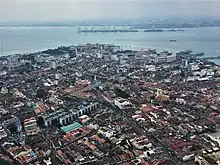
The oldest portion of the city centre has been designated by UNESCO as a World Heritage Site since 2008.[24] Recognised as having a "unique architectural and cultural townscape without parallel anywhere in East and Southeast Asia", George Town contains one of the largest collections of pre-war buildings in Southeast Asia.[24][131][132]
The World Heritage Site covers nearly 260 ha (2.6 km2) of the city centre, roughly bounded by Transfer Road to the west and Prangin Road to the south.[133] The zone includes the city's administrative precinct, which is home to the most historic landmarks like Fort Cornwallis, City Hall and the Penang State Museum, as well as the main Central Business District along Beach Street.[54] The zone also covers various places of worship, such as St. George's Church, the Kapitan Keling Mosque and the Goddess of Mercy Temple, as well as the Cheong Fatt Tze Mansion and the Eastern & Oriental Hotel.[134]
Among the restrictions in force within the zone is a ban on the construction of any structure exceeding 18 m (59 ft) in height, and that any new building which is located adjacent to a historically important structure must not exceed the height of the latter.[135][136]
Street names

Unlike other cities in Malaysia, George Town still retains most of its English street names.[137][138][139] Even for roads that have been renamed in Malay, such as Jalan Masjid Negeri, Penangites in general still use the road's former colonial name, which in this particular case is Green Lane.[140] This is partly because the new names are often unwieldy (e.g. Pitt Street vs Jalan Masjid Kapitan Keling, Northam Road vs Jalan Sultan Ahmad Shah), but also reflects a strong conservatism in the local population, who see Penang's colonial history as part of their local identity.[141]
Since 2008, multi-lingual road signs have been in use throughout Penang Island. Each of the new road signs shows the street's official Malay name and either the street's English, Chinese, Tamil or Arabic name.[142][143]

Suburbs
The expansion of George Town has created suburbs to its northwest, west and south. The northwestern suburbs are somewhat more affluent, given their seafront locations which attract tourists and expatriates.[144][145][146] The southern suburbs, such as Jelutong, grew due to industrial activities.[147] On the other hand, Air Itam and Paya Terubong emerged to the west of the city centre as a result of agricultural plantations on the central hills of Penang Island.[148][149]
Since the 1970s, massive industrialisation around Bayan Lepas, which created the Bayan Lepas Free Industrial Zone, led to the rapid urbanisation of the southeastern corner of Penang Island as well.[106] The western half of the island, where Balik Pulau forms the main population centre, has also witnessed significant urbanisation in recent years.[126][150]
Beaches and seafronts

The most popular beaches of George Town are situated along the city's northwestern suburbs, specifically Batu Ferringhi, Tanjung Bungah and Tanjung Tokong. Several hotels and resorts have been established along these locations, including Hard Rock Hotel.[144][145] Aside from these, George Town is home to popular promenades such as Gurney Drive, the Esplanade and Karpal Singh Drive. In particular, Gurney Drive forms part of the city's second Central Business District, and is a shopping haven with two upmarket shopping malls – Gurney Plaza and Gurney Paragon.[151][152] Land reclamation is currently ongoing off Gurney Drive in a state-led effort to create a seafront public park named Gurney Bay.[153]
Hills
The central hills of Penang Island, situated to the west of the city centre, serve as a gigantic green lung and water catchment area for the urbanised island.[154] Rising 833 m (2,733 ft) above sea level, the peak of Penang Hill is accessible via the Penang Hill Railway from its base station at Air Itam. Once a retreat used by British officials and Queen Elizabeth II, Penang Hill is one of Penang's most well-known tourist attractions.[155][156]
%252C_George_Town%252C_Penang.jpg.webp)
Parks
Founded in 1884 as an offshoot of the Singapore Botanic Gardens, the Penang Botanic Gardens is Malaysia's oldest botanical garden. Today, it serves as a major recreational area, receiving about 5,000 visitors every weekend.[157] This botanical garden also encompasses Penang's biggest waterfall, which forms part of George Town's water supply.[158] Meanwhile, the nearby 172-acre (70 ha) City Park was officially opened in 1972.[159]
The city is also home to the world's smallest national park – the Penang National Park. Covering 2,562 ha (25.62 km2) of the northwestern tip of Penang Island, it contains mangrove swamps, rainforest interspersed with hiking trails and tranquil beaches.[160] Other notable natural attractions nearby include the Tropical Spice Garden and the Entopia Butterfly Farm, the latter of which was Malaysia's first butterfly sanctuary.[161][162]
Climate
The city features a tropical rainforest climate, under the Köppen climate classification (Af). George Town experiences relatively consistent temperatures throughout the course of the year, with an average high of about 32 °C and an average low of 24 °C.[163] The city sees on average about 2,477 millimetres (97.5 in) of precipitation annually.[164]
George Town's proximity to the island of Sumatra makes it susceptible to dust particles carried by wind from the perennial but transient forest fires, creating a yearly phenomenon known as the Southeast Asian haze.[165]
Weather forecast in George Town is served by the Penang Meteorological Office in Bayan Lepas, which acts as the primary weather forecast facility for northern Peninsular Malaysia.[166]
| Climate data for George Town (Penang International Airport) (1991–2020 normals, extremes 1934–2020) | |||||||||||||
|---|---|---|---|---|---|---|---|---|---|---|---|---|---|
| Month | Jan | Feb | Mar | Apr | May | Jun | Jul | Aug | Sep | Oct | Nov | Dec | Year |
| Record high °C (°F) | 35.2 (95.4) |
35.8 (96.4) |
36.2 (97.2) |
36.0 (96.8) |
36.0 (96.8) |
34.5 (94.1) |
34.7 (94.5) |
34.3 (93.7) |
33.8 (92.8) |
34.5 (94.1) |
34.0 (93.2) |
34.0 (93.2) |
36.2 (97.2) |
| Average high °C (°F) | 31.9 (89.4) |
32.4 (90.3) |
32.6 (90.7) |
32.3 (90.1) |
32.1 (89.8) |
32.0 (89.6) |
31.6 (88.9) |
31.4 (88.5) |
31.1 (88.0) |
31.0 (87.8) |
31.1 (88.0) |
31.3 (88.3) |
31.7 (89.1) |
| Daily mean °C (°F) | 27.8 (82.0) |
28.1 (82.6) |
28.4 (83.1) |
28.4 (83.1) |
28.4 (83.1) |
28.3 (82.9) |
27.9 (82.2) |
27.7 (81.9) |
27.4 (81.3) |
27.2 (81.0) |
27.2 (81.0) |
27.4 (81.3) |
27.8 (82.0) |
| Average low °C (°F) | 24.6 (76.3) |
24.7 (76.5) |
25.0 (77.0) |
25.2 (77.4) |
25.3 (77.5) |
25.2 (77.4) |
24.9 (76.8) |
24.7 (76.5) |
24.4 (75.9) |
24.3 (75.7) |
24.4 (75.9) |
24.5 (76.1) |
24.8 (76.6) |
| Record low °C (°F) | 19.0 (66.2) |
18.0 (64.4) |
20.5 (68.9) |
22.0 (71.6) |
20.5 (68.9) |
20.0 (68.0) |
20.0 (68.0) |
21.0 (69.8) |
20.0 (68.0) |
20.5 (68.9) |
19.5 (67.1) |
19.5 (67.1) |
18.0 (64.4) |
| Average precipitation mm (inches) | 80.3 (3.16) |
85.8 (3.38) |
145.5 (5.73) |
188.4 (7.42) |
229.1 (9.02) |
163.5 (6.44) |
189.8 (7.47) |
246.3 (9.70) |
316.4 (12.46) |
336.6 (13.25) |
232.8 (9.17) |
116.5 (4.59) |
2,331 (91.77) |
| Average precipitation days (≥ 1.0 mm) | 6.8 | 6.0 | 9.8 | 13.6 | 13.0 | 9.9 | 10.0 | 13.2 | 15.5 | 18.3 | 15.7 | 10.8 | 142.6 |
| Average relative humidity (%) | 75 | 78 | 81 | 84 | 85 | 84 | 84 | 85 | 86 | 87 | 85 | 78 | 83 |
| Mean monthly sunshine hours | 191 | 204 | 201 | 191 | 178 | 171 | 172 | 169 | 167 | 161 | 164 | 169 | 2,138 |
| Source 1: World Meteorological Organization[167] | |||||||||||||
| Source 2: Ogimet[168]Deutscher Wetterdienst (humidity),[169] | |||||||||||||
Governance and politics
Local government

Local administration of George Town and all of Penang Island is carried out by the Penang Island City Council, which comes under the purview of the Penang state government. With a history dating back to 1800, it is Malaysia's oldest local government and the successor to the nation's first city council – the George Town City Council.[46]
Headquartered in the City Hall, the city council is responsible for urban planning, heritage preservation, public health, sanitation, waste management, traffic management, environmental protection, building control, social and economic development, and general maintenance of urban infrastructure.[170] In 2018, George Town was recognised as one of the cleanest cities in ASEAN, following a 2017 ranking which placed George Town as Malaysia's second cleanest city.[171][172]
The Mayor of Penang Island is appointed by the Penang state government every two years, while each of the 24 councillors is appointed for a one-year term.[173] The current Mayor is Rajendran P. Anthony, who took office in 2023.[174]
State government
As the capital of the State of Penang, George Town is the seat of the Penang state government. The Office of the Chief Minister of Penang is housed within the Komtar Tower, Penang's tallest skyscraper.[175] The unicameral Penang State Legislative Assembly convenes inside the State Assembly Building at Light Street.[36] The Governor of Penang, the head of state, also has his official residence within the city.[48]
In the State Legislative Assembly, George Town is represented by 19 state constituencies, namely Padang Kota, Pengkalan Kota, Komtar, Kebun Bunga, Pulau Tikus, Tanjong Bunga, Air Putih, Air Itam, Paya Terubong, Seri Delima, Datok Keramat, Sungai Pinang, Batu Lancang, Batu Uban, Pantai Jerejak, Batu Maung, Bayan Lepas, Pulau Betong and Telok Bahang.[176][177] The members of the State Legislative Assembly, known as State Assemblymen, are elected into office via the Penang State Election, which by convention is held simultaneously with the Malaysian General Election every five years.[178]
The city is also represented by six Members of Parliament in the Malaysian Parliament, who are elected via the Malaysian General Election.[179] The parliamentary constituencies are Tanjong, Bukit Bendera, Jelutong, Bukit Gelugor, Bayan Baru and Balik Pulau.[176][177]
Judiciary
.jpg.webp)
The Malaysian legal system had its roots in George Town. By 1807, Penang was accorded a Royal Charter which provided for the establishment of a Supreme Court and the appointment of the first Supreme Court judge, designated as the Recorder.[42][43]
The Supreme Court of Penang (now High Court of Penang) was first opened at Fort Cornwallis on 31 May 1808.[42][43] Edmond Stanley assumed office as the First Recorder of the Supreme Court of Penang in 1808, thus serving as Malaya's first Superior Court Judge.[42] The Supreme Court was then relocated a short distance away to Light Street, where the present building was built in 1903.[36][180]
Today, the Malaysian judiciary has become largely centralised. The courts in George Town consist of the Magistrates, Sessions and the High Court, the latter of which sits at the top of Penang's judicial system. The High Court remains at Light Street to this day, along with the Magistrates and Sessions Court across the street.[181] Another Sessions Court has also been established in Balik Pulau to the west.[182]
Demographics
According to the 2020 Census carried out by the Malaysian federal government, George Town had a population of 794,313, out of which 158,336 resided within the 19 km2 (7 sq mi) city centre, demarcated by the original pre-1974 city limits.[5] This makes the city centre among the densest urban areas in Asia, and George Town the eighth most populous city in Malaysia.[183]
The expansion of George Town's suburbs in the latter half of the 20th century and massive industrialisation to the south caused population decentralisation, as the city's inhabitants moved towards the suburban townships.[99][100][101] As a result, Mukim 13, covering Paya Terubong, Farlim, Relau, Bukit Jambul and Batu Uban, became the most populous sub-district within George Town, with a total of 226,712 residents in 2020.[5][184]
The George Town Conurbation, which also covers Seberang Perai, and parts of neighbouring Kedah and Perak, was home to 2,833,957 residents as of 2020, making it the second most populous metropolitan area in Malaysia after the Klang Valley.[5][185]
Ethnicities
According to Malaysia's Department of Statistics, George Town is a Chinese-majority city; as of 2020, over 51% of the urban population consisted of ethnic Chinese, including the Peranakans.[5] The Bumiputeras, which include ethnic Malays and East Malaysian indigenous races like the Dayaks and Kadazans, collectively made up 31% of the city's population.[186][187] Ethnic Indians comprised another 8% of George Town's population. These are in addition to small, but prominent, Eurasian and Siamese minorities.[188] In particular, most of the nearly 1,500 Eurasians remain concentrated at the Pulau Tikus suburb.[189][190]
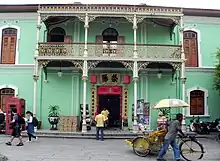
The Peranakans, descendants of mixed Malay and Chinese ancestries, were once the political and business elites in George Town. They held the top positions in some of the city's most influential associations, such as the Penang Chinese Chamber of Commerce and the Penang Straits Chinese British Association.[85] As the Peranakans tended to be more loyal to the British Crown than to China, they were also known as the King's Chinese.[191][192] In spite of Malaysia's ethnic policies that have effectively forced the Peranakans to identify themselves as Chinese, Peranakan culture still thrives in George Town to this day, in the form of Straits Chinese architectural styles and dishes like asam laksa.[193]
George Town currently has a sizeable expatriate population, especially from Singapore, Japan and various Asian countries as well as the United Kingdom, many of whom chose to retire in Penang as part of Malaysia My Second Home programme. In recent years, George Town has been acknowledged as one of the best cities for retirement within Southeast Asia by the likes of CNN and Forbes.[194][195] As of 2020, expatriates made up more than 8% of George Town's population, reflecting the city's popularity amongst foreigners.[196][197]

The city was also once home to Burmese, Filipino, Sinhalese, Japanese, Sumatran, Arab, Armenian and Persian communities.[198] A small but commercially significant community of German merchants existed in George Town as well, as did a Jewish enclave.[199] Even though most of these other communities, including the Jews, are no longer extant, they lent their legacy to numerous street and place names such as the Dhammikarama Temple, Burmah Road, Armenian Street, Jewish Cemetery and Gottlieb Road.[198][200][201]

Languages
As with other multi-ethnic cities in Malaysia, all four major languages are widely spoken in George Town – Malay, English, Mandarin and Tamil. However, George Town, and by extension Penang, is best known for its distinct Hokkien dialect, known as Penang Hokkien.[203]
During the British colonial era, English was the official language. This was helped by the mushrooming of missionary schools throughout George Town, all of which used English as their medium of instruction and were held in high esteem by the locals.[204] Most Penangites still maintain reasonable command of the language; while British English is formally used, spoken English usually takes the form of Manglish.[205]
As in the rest of Malaysia, Malay is currently the official language in George Town. The city's Malays also use a variant of the Kedah Malay dialect, with slight modifications made to the original dialect to suit the conditions of a cosmopolitan city.[206] These modifications include the use of words of Indian (Tamil/Hindustani possibly Urdu), English, and Arabic origin, the alteration of final "l" into "i" (also the standard in Kedah Malay), and expressions calqued from Tamil, as well as original words and idiomatic forms unique to the George Town area.[206]
Due to their Tamil/South Indian ancestry, most Indians in George Town speak Tamil. Punjabi and Telugu are also spoken by a very smaller numbers of Indians.[207][208]
Mandarin, more widely used by youths, has been the medium of instruction in Chinese schools throughout Penang.[209]
However, Penang Hokkien serves as the lingua franca of George Town. Originally a variant of the Minnan dialect, over the centuries, Penang Hokkien has incorporated a large number of loanwords from Malay and English. It is spoken by many Penangites regardless of race for communication purposes.[203][210][211] In recent years, there have been more efforts to maintain the dialect's relevance in the face of the increasing influence of Mandarin and English among the younger populace.[212][213]
Economy
As the capital city of Penang, one of the most urbanised states in Malaysia, George Town is one of the top contributors of Malaysia's Gross Domestic Product (GDP), tax and export revenues.[214][215][216][11] According to the Economist Intelligence Unit, the city contributed US$12,044, or nearly 8%, of Malaysia's personal disposable income in 2015, the second highest after Kuala Lumpur.[7] In 2016, George Town was ranked Malaysia's most attractive destination for commercial property investment by Knight Frank, surpassing even Kuala Lumpur.[217] By 2017, Penang's GDP per capita, already the highest among Malaysian states, rose to RM49,873, thereby surpassing the World Bank's threshold to be considered a high-income economy.[218][219] George Town's popularity amongst foreign investors has contributed to Penang gaining the largest share of Malaysia's foreign direct investments within the same year.[220]
Originally established as an entrepôt by the British, George Town's economy is now dominated by other tertiary sub-sectors ranging from manufacturing to finance, whilst newer industries, including entrepreneurial startups, are taking root within the city as well.[8] In addition, George Town serves as the economic pole of northern Malaysia, with relatively wide logistical connectivity.[215] The Penang International Airport is one of the nation's busiest, whilst Swettenham Pier has cemented the city's reputation as a popular destination for cruise shipping.[15][216][221]
Manufacturing

Since the 1970s, manufacturing formed the backbone of Penang's economy, generating 44.8% of the state's GDP as of 2017 and attracting about 3,000 firms to set up operations within the state, including over 300 multinational companies.[218][223][224] The Bayan Lepas Free Industrial Zone, dubbed the Silicon Valley of the East, is the main electronics manufacturing hub within Malaysia.[8][9][225] Located at the southeastern corner of Penang Island, the zone is home to various high-tech multinational firms such as Dell, Intel, AMD, Motorola, Agilent, Renesas, Osram, Bosch, Sony and Seagate.
A well-established electronics ecosystem and supply chain comprising both multinational corporations and large local companies (LLCs) have solidified George Town's position as the largest exporter among Malaysian cities.[226] An estimated RM295,173 million worth of exports passed through the Penang International Airport in 2021.[10][11]
Finance

George Town was the centre of banking in Malaysia at a time when Kuala Lumpur was still a small outpost. The oldest bank in Malaysia, Standard Chartered, opened its main branch in George Town in 1875 to cater to the financial requirements of early European traders.[36][54] This was followed by HSBC in 1885 and the Royal Bank of Scotland in 1888.[36][54]
Today, George Town remains the banking hub of northern Malaysia, with branches of major international banks such as Standard Chartered, HSBC, Citibank, UOB, OCBC, Bank of China and Bank Negara Malaysia (Malaysian central bank).[227] Most of the foreign banks still maintain their Penang headquarters at Beach Street, which serves as the city's main Central Business District.[54]
Since the 1990s, Northam Road, along with Gurney Drive, has evolved into George Town's second Central Business District.[228] Northam Road is now home to a cluster of financial services, with a number of accounting, auditing and insurance firms based along this coastal road.[229] In addition to these, the Employees Provident Fund, run by the Malaysian federal government, operates an office at the road as well.[230]
The financial sector and its related industries, such as insurance, auditing and real estate transactions, accounted for over 8% of Penang's Gross Domestic Product (GDP) as of 2017.[218]
Tourism
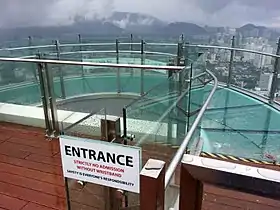
George Town has always been one of the most popular tourist destinations in Malaysia. Throughout history, the city has even welcomed some of the most influential personalities, including Somerset Maugham, Rudyard Kipling, Noël Coward, Lee Kuan Yew and Queen Elizabeth II.[232][233]
In recent years, George Town has received numerous international accolades, further putting the city on the world stage.[234] The city has been listed by various publications, including the Lonely Planet, Forbes and Time, as one of the top travel destinations in Asia.[23][235][236][237][238] These are in addition to George Town's reputation as a gastronomic haven, with the CNN placing the city as one of Asia's best street food cities.[21]
Unlike most other Malaysian cities, George Town does not rely only on air transportation for tourist arrivals. Aside from the Penang International Airport, Swettenham Pier, conveniently located within the city centre, also serves as one of the major tourist entry points into Penang. As of 2017, Penang attracted almost 8.6 million tourists, with the airport posting a record 7.2 million passenger arrivals and the pier registering another 1.35 million tourist arrivals.[239][240] Within the same year, Penang became the third largest contributor of Malaysia's tourism tax revenue after Kuala Lumpur and Sabah.[241]
The Penang state government launched its ten-year Penang Tourism Master Plan in 2019 with the goal of ensuring sustainable development of Penang as a regional hub for tourism, heritage, culture and arts.[242] George Town World Heritage Incorporated (GTWHI) – the state's independent heritage agency responsible for managing the George Town World Heritage Site – has also produced a Sustainable Tourism Strategy action plan to promote a more sustainable form of tourism with greater emphasis on heritage conservation and community participation.[243]
.jpg.webp)
Services
With nearly 3⁄5 of Penang's workforce employed in services-related fields, the services sector has marginally overtaken manufacturing as Penang's biggest economic sector, contributing 49.3% of Penang's total GDP in 2017.[218][244] The largest share of employment was recorded in the retail, hospitality, and food and beverages (F&B) sub-sectors, clearly depicting the influence of tourist arrivals on service-related industries.[244] Since the inscription of George Town as a UNESCO World Heritage Site, an emerging trend is the acquisition of heritage shophouses within the zone by foreign investors, especially from Singapore and Hong Kong.[115][116][245]
In addition, a startup community has been growing in the city, which include the likes of Piktochart and DeliverEat.[8] Attracted by the city's cheaper living costs and the presence of several multinational technology firms in Penang, the city's startups are also being actively encouraged by the Penang state government and the private sector, with initiatives to encourage entrepreneurship and promote the Internet of Things (IoT).[246][247]
This services sector has also been boosted by firms seeking to establish shared services outsourcing (SSO) operations within or around George Town, including AirAsia, Citigroup, Dell, Jabil and Temasek Holdings.[223][248] Consequently, Penang has emerged as the second most important Global Business Services (GBS) hub within Malaysia, after Kuala Lumpur.[249]
Spurred by the city's industrial and services sectors, George Town is emerging as a meetings, incentives, conferencing and exhibitions (MICE) destination within Southeast Asia, playing host to international trade fairs and business events such as the World Congress on Innovation and Technology (WCIT) by the World Innovation, Technology and Services Alliance (WITSA), SEMICON Southeast Asia and the 7th Asia Pacific Urban Forum.[224][250][251][252]
Medical tourism
An integral part of Penang's services sector is medical tourism, which has made George Town the medical tourism hub of Malaysia. The city has attracted approximately half of Malaysia's medical tourist arrivals in 2013 and generated about 70% of the nation's medical tourism revenue.[13][14][96] About 1,000 patients arrive in George Town daily, mostly from Asian countries such as Indonesia, Singapore and Japan.[13][14]
The success of George Town's medical tourism industry is mainly due to the specialised medical treatments offered at more affordable costs by the city's numerous private hospitals, coupled with well-trained professionals and advanced equipment.[96] Indirect factors that were cited include the relatively low cost of living and the ease of travel facilitated by the well-developed logistical infrastructure.[13]
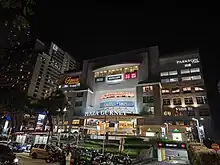
Retail
As many as 24% of Penang's workforce are employed in the retail sub-sector, the largest of all economic sub-sectors in Penang.[244] Due to the numerous shopping malls and hypermarkets in George Town, the city is the main shopping hub of northern Malaysia. Since 2001, shopping complexes in George Town registered the biggest increases in Malaysia.[253] Among the more well-known shopping malls within the city are Gurney Plaza, Gurney Paragon, 1st Avenue and Queensbay Mall.[254]
While shopping malls now dominate the retail scene in George Town, many centuries-old shophouses are still operating alongside the city's flea markets and wet markets, such as Chowrasta Market.[253][255] These traditional retail establishments cater more to locally made products, including spices, nutmegs and tau sar pneah, a famous Penang delicacy.[256]
Architecture
Centuries of development have brought a mix of architectural styles to George Town, both historical and modern. The oldest portion of the city centre is a UNESCO World Heritage Site, while outside the UNESCO zone lies the modern cityscape, with skyscrapers, residential high-rises, office blocks and shopping malls built all over the city.[24][131]
Historic architecture

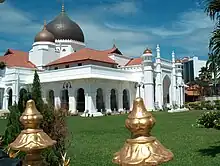
Most of George Town's famous heritage landmarks, including Fort Cornwallis, the City Hall, the High Court, St. George's Church and the Eastern & Oriental Hotel are located within the UNESCO World Heritage Site.[54] The city's main Central Business District at Beach Street, also within the UNESCO zone, is home to banks built in various Art Deco-based hybrid styles.[36][54][257] Colonial-era bungalows, such as The Residency and Suffolk House, can be found throughout the city as well.[36]
Aside from colonial European architecture, a huge assortment of Asian architectural styles also exist throughout the city. Buildings like the Kapitan Keling Mosque, Kong Hock Keong Temple, Cheong Fatt Tze Mansion and the Pinang Peranakan Mansion are notable for their architectural styles, which combine diverse cultural influences. Peranakan townhouses, exemplified by the Sun Yat-sen Museum, dominate the cityscape as well.[258] Meanwhile, Indian architecture is more prominent within the city's Little India, which also contains the Sri Mahamariamman Temple.[259]
In the suburbs, the Siamese and Burmese communities have left their mark too; the Buddhist temples at Pulau Tikus include Wat Chaiyamangkalaram and the Dhammikarama Temple. Another example of a hybrid Asian architecture is the Kek Lok Si Temple at Air Itam, which merges Chinese, Siamese and Burmese influences.[260]
Modern architecture
Since the mid 20th century, modern urbanisation has transformed much of George Town. Just south of the UNESCO World Heritage Site stands the Komtar Tower, the tallest skyscraper in Penang at nearly 250 m (820 ft) tall. The second Central Business District at Northam Road and Gurney Drive, which lies along the city's northern shoreline, is also home to some of Penang's tallest skyscrapers, including Setia V, Gurney Paragon and BHL Tower.[261]
With increasing urbanisation, high-rises are also springing up within the suburbs of George Town.[262]
Culture
Food

George Town, long known as the food capital of Malaysia, is renowned for its good and varied street food, incorporating Malay, Chinese, Indian, Peranakan, Thai and European influences into its literal melting pot.[22]
The city has been recognised as one of Asia's top street food cities by CNN, as well the world's top culinary destination by the Lonely Planet in 2014.[21][22] These were in addition to the Time magazine in 2004, which acclaimed Penang as having the best street food in Asia.[264]
The best places to savour street cuisine include Gurney Drive, Pulau Tikus, Chulia Street, Kimberley Street, New Lane, New World Park, Penang Road and Air Itam.[265][266][267] The more prominent local dishes include asam laksa, char kway teow, curry mee, Hokkien mee, nasi kandar, oh chien (fried oyster omelette), rojak and chendol.[265][266][267] Besides these, several tau sar pneah shops can be found throughout the city, selling bean paste biscuits.[255]

Performance arts
George Town is the birthplace of a unique form of Chingay procession, which began with its first parade in 1919.[52][268] Penang's variant of Chingay includes the act of balancing gigantic flags on one's forehead or hands. An annual Chingay parade is held in the city every December, though Chingay performances are also a common feature of Chinese festivities and major state celebrations in Penang.[269]
Bangsawan is a form of Malay theatre which was developed in Penang with Indian, Western, Islamic, Chinese and Indonesian influences. It went into decline in the latter decades of the 20th century and is now a dying art form.[270][271] Boria is another traditional dance drama indigenous to Penang, featuring singing accompanied by violin, maracas and tabla.[272]
Aside from these, there are two Western orchestras based in George Town – the Penang Philharmonic and the Penang Symphony Orchestra (PSO) – as well as several chamber and school-based musical ensembles.[273][274] Dewan Sri Pinang and Penangpac within Straits Quay are two of the major performing venues in the city.[275]

Street art
In 2012, as part of the annual George Town Festival, Lithuanian artist Ernest Zacharevic created a series of wall murals depicting local culture, inhabitants and lifestyles.[276] They now stand as celebrated cultural landmarks of George Town, with Children on a Bicycle becoming one of the most photographed spots in the city.[277]
Since then, the street art scene has blossomed. Arts exhibitions are held at the city's numerous cultural centres, such as the Hin Bus Depot.[278] Aside from wall art, several wrought iron caricatures, each depicting a unique aspect of George Town's history and culture, have been installed throughout the city centre.[279]
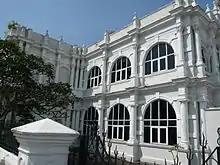
Museums
The Penang State Museum and Art Gallery houses relics, photographs, maps, and other artifacts that document the history and culture of Penang.[280] Other museums within the city focus on religious and cultural aspects, as well as famous personalities, including the Penang Islamic Museum, Sun Yat-sen Museum, P. Ramlee's House, Batik Painting Museum, and Universiti Sains Malaysia Museum and Gallery.[281][282]
In recent years, private-run museums have sprung up all over the city, such as the Camera Museum and the Penang Toy Museum. A handful of newer visual museums have also been launched, such as the Made-in-Penang Interactive Museum and the Penang Time Tunnel.[283][284]
Festivals
George Town's cultural melting pot of various races and religions means that there are a great many celebrations and festivities in any given year. The major cultural and religious festivities in George Town include, but not limited to, the Chinese New Year, Chap Goh Meh, Songkran, Wesak Day, Seventh Month Festival, Nine Emperor Gods Festival, Eid ul-Fitri, Deepavali, Thaipusam, Vaisakhi and Christmas.[285][286]
The city's expatriates have introduced a host of other celebrations as well. Bon Odori is celebrated yearly at the Esplanade by the Japanese, while St. Patrick's Day and Oktoberfest, traditionally celebrated by the Irish and the Germans respectively, have also been gaining popularity amongst the locals.[287][288][289]
In addition, the city hosts several major festivals in any given year. The George Town Festival, first held in 2010, has evolved into one of the top arts events in Southeast Asia, while the Penang Hot Air Balloon Fiesta attracts close to 200,000 visitors from all over the world.[290][291]
Sports

George Town has a relatively well-developed sporting infrastructure. The City Stadium is Penang Island's main football stadium, with a capacity of about 25,000.[292][293] It is the home ground of Penang FA, and was where Penang footballer Mohd Faiz Subri scored the goal that won him the 2016 FIFA Puskás Award.[294] SPICE Arena at Bayan Baru consists of an indoor stadium, an aquatics centre and a convention centre, while the Nicol David International Squash Centre at Gelugor is a major squash training facility.[295] In addition, the Penang Turf Club, established in 1864, is Malaysia's oldest horse racing and equestrian centre.[232]
The Penang Bridge International Marathon is a popular annual event. The full marathon route starts from near Queensbay Mall, then on to the 13.5 km (8.4 mi) length of the Penang Bridge, and finally back to the starting point for the finish.[296]
The national and international sporting events that were held in George Town include the 2001 Southeast Asian Games and the 2013 Women's World Open Squash Championship.[297][298] In addition, George Town hosted the inaugural edition of the Asia Pacific Masters Games in 2018.[299]

Education
George Town is home to some of the oldest schools in Malaysia, making it a pioneer in the country's education system. Under British rule, missionary schools were set up across George Town. They were followed by Chinese schools, some of which are also among the oldest in the nation, thus making George Town the nucleus of Chinese education in Southeast Asia.[52][300] More recently, international schools have also been established to cater to the growing expatriate population.
In addition, George Town contains a number of private tertiary educational institutions, as well as one of the premier Malaysian public universities – Universiti Sains Malaysia. Aside from these, the city has a handful of language institutions, such as the British Council, Alliance Française and the Malaysian German Society.[301][302][303]
Schools
There are a total of 117 primary schools, 49 high schools, four Islamic religious schools, two vocational colleges and a technical school throughout George Town.[304] The breakdown of these schools is as follows.
| Type | Total | |
|---|---|---|
| Primary schools | National | 53 |
| National-type Chinese | 51 | |
| National-type Tamil | 7 | |
| Private | 4 | |
| Special needs | 2 | |
| High schools | National | 42 |
| Private | 6 | |
| Special needs | 1 | |
| Islamic | 4 | |
| Technical/vocational | 3 | |
Some of the oldest missionary schools in George Town include the Penang Free School, St. Xavier's Institution, Convent Light Street, St. George's Girls' School and Methodist Boys' School.[305] Meanwhile, the Chung Hwa Confucian School, founded in 1904, was the first Chinese school in Southeast Asia.[52]
Aside from government-run and private schools, the city has 11 international schools. Of these, Dalat, Uplands, Tenby, Fairview, Pelita and Wesley Methodist offer both primary and secondary education.[306][307][308] The Penang Japanese School is the only international school in George Town that caters for expatriates of a specific nationality.[309]
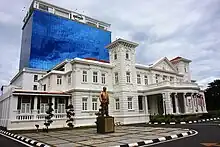
Tertiary education
Universiti Sains Malaysia, situated at Gelugor, is one of the premier Malaysian public universities. Established in 1969 as Malaysia's second university, it was originally named Universiti Pulau Pinang (University of Penang).[310] As of 2018, it was ranked 207th in the QS World University Rankings, the fourth highest in Malaysia.[311]
Several private universities and colleges have also been set up across George Town, including Wawasan Open University, Royal College of Surgeons in Ireland and University College Dublin Malaysia Campus, Han Chiang University College of Communication, DISTED College, SEGi College, Sentral College, Lam Wah Ee Nursing College, Adventist College of Nursing and Health Sciences, Equator Academy of Arts and KDU University College.[312][313]
Libraries
George Town contains a total of 30 libraries.[304] Among the libraries in the city are the Northeast Penang Island District Library at Scotland Road and the Penang Digital Library at Green Lane.[314][315] The latter, which was opened by the Penang state government in 2016, is Malaysia's first digital library and houses a digitalised collection of over 3,000 publications.[316][317]
Health care
The numerous public and private hospitals in George Town has helped the city to emerge as the centre of medical tourism in Malaysia. The Penang General Hospital, administered and funded by the Ministry of Health, is the main public hospital in George Town and serves as the tertiary referral hospital within northern Malaysia.[318] It is complemented by the Balik Pulau Hospital, which is also managed by the country's Ministry of Health.[319]
There are also 54 government-run clinics throughout George Town, supported by 11 private hospitals and 352 private clinics.[320] The private hospitals within George Town include Penang Adventist Hospital, Island Hospital, Gleneagles Medical Centre, Loh Guan Lye Specialists Centre, Lam Wah Ee Hospital, Mount Miriam Cancer Hospital, Pantai Hospital and Kek Lok Si Charitable Hospital.
George Town became the first Malaysian city to install public automated external defibrillators (AEDs), with the launch of the first device in Komtar in 2015.[321][322] Since then, AEDs have been installed at several public locations throughout the city.[323][324]
Media
Print
George Town was once the centre of Malaysia's print media, where the country's first newspaper – the Prince of Wales Island Gazette – first came to being.[63] One of Malaysia's top dailies currently in circulation, The Star, was founded in George Town in the 1970s, while the country's oldest Chinese newspaper, Kwong Wah Yit Poh, was also founded in the city in 1910.[63]
In 2011, the then Chief Minister of Penang, Lim Guan Eng, officiated the launch of the Penang edition of Time Out.[325] This version of the international listings magazine is currently published in three versions – an annual guide, a website and a mobile app.[326]
The Penang state government also publishes its own multi-lingual newspaper, Buletin Mutiara, which is circulated for free every fortnight.[327] The Penang-centric newspaper focuses on the current issues affecting Penang.[327]
Television
Due to its well-preserved heritage cityscape, George Town served as the filming location for a number of movies, such as Anna and the King, Lust, Caution and You Mean the World to Me, the latter of which is the first movie to be filmed entirely in Penang Hokkien.[328] Singaporean drama series, The Little Nyonya and The Journey: Our Homeland, were also shot within the UNESCO zone.[329][330] In addition, the city was one of the pit-stops of The Amazing Race 16, The Amazing Race Asia 4 and The Amazing Race Asia 5.
Radio
The available FM radio stations in George Town, both government (including Penang-based Mutiara FM) and commercial, are as listed below.[331]
| Frequency | Station | Operator | Language |
|---|---|---|---|
| 87.8 | One FM | Media Prima | Mandarin, Cantonese |
| 88.2 | Hot FM | Media Prima | Malay |
| 89.9 | Fly FM | Media Prima | English |
| 90.2 | Kool FM | Media Prima | Malay |
| 91.0 | Mix FM | Astro Radio | English |
| 92.8 | Hitz FM | Astro Radio | English |
| 94.5 | 988 FM | Star RFM Radio | Mandarin, Cantonese |
| 94.9 | Klasik FM | RTM | Malay |
| 95.7 | Mutiara FM | RTM | Malay |
| 96.7 | Minnal FM | RTM | Tamil |
| 97.1 | Sinar FM | Astro Radio | Malay |
| 98.7 | TraXX FM | RTM | English |
| 99.3 | THR Raaga | Astro Radio | Tamil |
| 99.7 | My FM | Astro Radio | Mandarin, Cantonese |
| 101.3 | Ai FM | RTM | Mandarin, Cantonese, Hokkien |
| 103.6 | Era FM | Astro Radio | Malay |
| 104.4 | Lite FM | Astro Radio | English |
| 106.5 | Melody | Astro Radio | Mandarin, Cantonese |
| 106.9 | Suria FM | Star RFM Radio | Malay |
| 107.6 | goXuan | Astro Radio | Mandarin, Cantonese |
Transportation

Land
Development of George Town's streets and roads is an ongoing process that dates back to the early years of British rule. The city's oldest streets, including Light Street, Beach Street, Chulia Street and Pitt Street, were arranged in a grid pattern.[332]
The Tun Dr Lim Chong Eu Expressway runs along the eastern coastline of Penang Island between the city centre and the Penang International Airport, linking both locations with the Bayan Lepas Free Industrial Zone, the Penang Bridge and the Second Penang Bridge. The George Town Inner Ring Road and the Penang Middle Ring Road are the two major ring roads around the city centre, which is also linked with Balik Pulau via the pan-island Federal Route 6.
Both the 13.5 km (8.4 mi)-long Penang Bridge and the 24 km (15 mi)-long Second Penang Bridge link George Town with the rest of Peninsular Malaysia. Completed in 1985, the Penang Bridge provides direct access from the suburb of Gelugor to Central Seberang Perai, while the Second Penang Bridge, opened in 2014, lies to the south, linking the suburb of Batu Maung with Southern Seberang Perai.[333]

Public transportation
George Town was once a pioneer of public transportation in British Malaya. The city's first tram system, then powered by steam, commenced operations in the 1880s.[335][336] While the tram lines have since been disused, another colonial legacy, the trishaw, remains in use throughout the city, albeit catering primarily for tourists.[337][338]
Today, buses form the backbone of public transportation within George Town. Rapid Penang, with over 30 routes on Penang Island, is the sole public bus service provider within George Town. Meanwhile, the Penang Hill Railway, opened in 1923, is a funicular railway providing direct access to the peak of Penang Hill.
Efforts are also being undertaken to promote pedestrianisation and the use of bicycles as a greener transportation mode.[113][339] Dedicated cycling lanes have been marked throughout the city and in 2016, George Town became the first Malaysian city to operate a public bicycle-sharing service, with the launch of LinkBike.[340]
To alleviate burgeoning traffic congestion within George Town caused by high population density and car ownership rate, plans are afoot by the Penang state government to introduce an urban rail network criss-crossing the city. The 29 km (18 mi) Bayan Lepas LRT line, stretching between the suburbs of Tanjung Bungah in the north and Bayan Lepas in the south with an interchange station at Komtar, is being prioritised for construction.[341][342]
Air
The Penang International Airport, 16 km (9.9 mi) south of the city centre, was opened in 1935. It serves as the main airport for northern Malaysia, with frequent links to major Asian cities such as Kuala Lumpur, Singapore, Bangkok, Jakarta, Ho Chi Minh City, Taipei, Hong Kong, Guangzhou and Doha. It is also a hub for two Malaysian low-cost carriers – AirAsia and Firefly.[343] The airport is Malaysia's second busiest in terms of cargo traffic and recorded the third highest passenger traffic of all Malaysian airports as of 2013.[344]
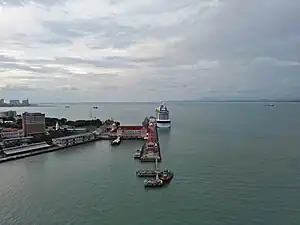
Sea
The Port of Penang consists of seven facilities along the Penang Strait, including Swettenham Pier in George Town.[345] Renovated in 2009 as a cruise shipping terminal, Swettenham Pier is one of the major tourist entry points into George Town.[16][221] As of 2017, the pier recorded 1.35 million tourist arrivals, thereby surpassing Port Klang as the busiest port-of-call in Malaysia for cruise shipping.[15][240] The pier has also attracted some of the world's largest cruise liners, such as the RMS Queen Mary 2.[16]
A number of cruise ships call Swettenham Pier as their homeport, bringing tourists into and out of George Town towards regional destinations like Phuket and Singapore.[346] Occasionally, the pier hosts warships as well, including those from Singapore, Thailand and the United States.[347][348][349]

Ferry
The Penang ferry service connects George Town with Butterworth in mainland Seberang Perai, across the Penang Strait. It is the oldest ferry service in Malaysia, dating back to 1894 when the first passenger ferry commenced operations.[69] With the introduction of new catamarans Teluk Bahang, Teluk Kampi, Teluk Duyung and Teluk Kumbar in 2023, frequency has been improved to every 20 minutes during peak hours and every 30 minutes during non-peak hours.[350]
International relations
Consulates
Several nations have either established their consulates or appointed honorary-consulates within George Town.[351]
.svg.png.webp) Australia[352]
Australia[352] Austria[353]
Austria[353]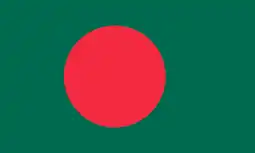 Bangladesh[354]
Bangladesh[354] Brazil[351]
Brazil[351] China[355]
China[355] Denmark[356]
Denmark[356] France[357]
France[357] Finland[358]
Finland[358] Germany[359]
Germany[359] Hungary[360]
Hungary[360] Indonesia[361]
Indonesia[361] Japan[362]
Japan[362] Kazakhstan[363]
Kazakhstan[363] Nepal[364]
Nepal[364] Norway[365]
Norway[365] Pakistan[366]
Pakistan[366] Poland[367]
Poland[367] Russia[368]
Russia[368] Sweden[369]
Sweden[369] South Africa[370]
South Africa[370] Thailand[371]
Thailand[371] United Kingdom[372]
United Kingdom[372] Ukraine[373]
Ukraine[373]
Sister cities
George Town is twinned with:
.svg.png.webp) Adelaide, Australia[374]
Adelaide, Australia[374] Xiamen, China[374]
Xiamen, China[374] Medan, Indonesia[374]
Medan, Indonesia[374] Bangkok, Thailand[375]
Bangkok, Thailand[375] Phuket, Thailand[376]
Phuket, Thailand[376]
The State of Penang also has a sister area partnership with Kanagawa Prefecture in Japan, which was ratified in 1991.[377]
Friendship cities
In addition to the sister cities and areas, George Town has inked following friendship city agreements:
 Chengdu, China[378]
Chengdu, China[378] Sanya, China[379]
Sanya, China[379] Zhongshan, China[380]
Zhongshan, China[380] Busan, South Korea[381]
Busan, South Korea[381] Changwon, South Korea[382]
Changwon, South Korea[382] Kaohsiung, Taiwan[381]
Kaohsiung, Taiwan[381] Taipei, Taiwan[383]
Taipei, Taiwan[383]
In 2013, the State of Penang signed a friendship state agreement with Hainan Province in China.[384]
References
- Mike Aquino (30 August 2012). "Exploring Georgetown, Penang". Asian Correspondent. Archived from the original on 1 January 2016. Retrieved 1 January 2016.
- "A Tropical Treasure: Life In George Town, Malaysia". Live and Invest Overseas. 2015. Retrieved 4 September 2022.
- Cavina Lim (25 March 2015). "Penang's First Mayor A Woman". The Star. Retrieved 24 January 2016.
- "Malaysia Elevation Map (Elevation of George Town)". Flood Map : Water Level Elevation Map. Archived from the original on 16 March 2015. Retrieved 25 September 2015.
- "Population and Housing Statistics". Key Findings Population and Housing Census of Malaysia 2020: Pulau Pinang (in Malay and English). Putrajaya: Department of Statistics (Malaysia). 29 May 2022. p. 96. ISBN 9789672535164.
- "The World According to GaWC 2020". GaWC - Research Network. Globalization and World Cities. Archived from the original on 12 June 2022. Retrieved 26 August 2020.
- "ASEAN Cities: Stirring the Melting Pot". Economist Intelligence Unit.
- Lianne Chia (26 January 2017). "A Silicon Valley of the East: Penang's thriving start-up community". Channel NewsAsia. Archived from the original on 29 January 2018. Retrieved 27 May 2017.
- Roughneen, Simon (15 July 2015). "Styling itself as the 'Silicon Valley of the East'". Nikkei Asian Review.
- "My Local Stats Barat Daya Pulau Pinang 2021". Department of Statistics Malaysia.
- "External Trade Cont. – StatsDW Portal". Retrieved 13 October 2023.
- Christina Oon Khar Ee; Khoo Suet Leng (2004). "Issues and challenges of a liveable and creative city: The case of Penang, Malaysia" (PDF). Development Planning and Management Programme, School of Social Sciences, University of Science, Malaysia. p. 1/11. ISSN 2180-2491. Archived from the original (PDF) on 26 January 2016. Retrieved 26 January 2016.
- Doris Liew, Lim Chee Han. "Medical Tourism A Billion Ringgit Industry for Penang". Penang Monthly. Archived from the original on 6 August 2017. Retrieved 25 May 2017.
- Hilmy, Imran (5 December 2014). "Penang accounts for 50% of medical tourists". The Sun.
- Edmund Lee (20 December 2017). "Swettenham Pier surpasses Port Klang as top port of call for cruise ships". The Sun.
- Filmer, Andrea (1 October 2015). "Is Penang's tourism on the right track?". Penang Monthly. Archived from the original on 22 March 2019. Retrieved 17 October 2016.
- Lewis, Su Lin (2016). Cities in Motion: Urban Life and Cosmopolitanism in Southeast Asia, 1920–1940. United Kingdom: Cambridge University. ISBN 9781107108332.
- Keat Gin, Ooi (2015). "Disparate Identities: Penang From A Historical Perspective, 1780-1941". Kajian Malaysia - Journal of Malaysian Studies. Malaysia: Universiti Sains Malaysia. 33 (2): 27–52.
- "pg.3 - Chapter 1 - Early Penang Society (contd)". 100pfs.blogspot.my. Retrieved 15 October 2016.
- "Eight new sites, from the Straits of Malacca, to Papua New Guinea and San Marino, added to UNESCO's World Heritage List". UNESCO (World Heritage Site). 7 July 2008. Archived from the original on 6 September 2015. Retrieved 8 July 2008.
- Goldberg, Lina (22 February 2013). "Asia's 10 greatest street food cities CNN Travel". CNN. Retrieved 27 May 2017.
- "Where are the foodies going in 2014?". The Independent. 2 February 2014. Retrieved 27 May 2017.
- "Looking for a 2016 vacation? Here are 16 must-see destinations". Los Angeles Times. 26 December 2015. ISSN 0458-3035. Retrieved 27 May 2017.
- Centre, UNESCO World Heritage. "Melaka and George Town, Historic Cities of the Straits of Malacca". UNESCO. Retrieved 13 October 2016.
- Ooi, Keat Gin (2010). The A to Z of Malaysia. Rowman & Littlefield. ISBN 9780810876415.
- Everett-Heath, John (2017). The Concise Dictionary of World Place Names. Oxford: Oxford University Press. ISBN 9780192556462.
- "Penaga Laut trees are back in George Town". The Star. 28 July 2008. Retrieved 18 March 2022.
- Sanjay, CS (16 July 2015). "The Right Spelling is George Town". The Star. Retrieved 21 February 2023.
- "The Founding of Penang". sabrizain.org. Retrieved 25 May 2017.
- "History of Penang". Visit Penang. 2008. Archived from the original on 2 January 2016. Retrieved 15 October 2016.
- Swettenham; Frank Athelstane (1850–1946). "Map to illustrate the Siamese question". W. & A.K. Johnston Limited. University of Michigan Library. Retrieved 9 January 2016.
- "Penang Notebook". 10 December 2015. Archived from the original on 27 December 2017. Retrieved 27 December 2017.
- "Francis Light | British military officer". Encyclopedia Britannica. Retrieved 27 December 2017.
- Jenkins, Gwynn (2008). Contested Space: Cultural Heritage and Identity Reconstructions : Conservation Strategies Within a Developing Asian City. LIT Verlag Münster. ISBN 9783825813666.
- Zabidi, Nor Diana. "Portal Rasmi Kerajaan Negeri Pulau Pinang – Fort Cornwallis 228th Anniversary Celebration" (in Malay). Penang Government. Archived from the original on 18 September 2017. Retrieved 25 May 2017.
- Hockton, Keith (2012). Penang: An Inside Guide to Its Historic Homes, Buildings, Monuments and Parks. Petaling Jaya: MPH Group. ISBN 978-967-415-303-8.
- Ashley Jackson (November 2013). Buildings of Empire. OUP Oxford. pp. 7–. ISBN 978-0-19-958938-8.
- Nordin, Hussin. "Malaysian Journal of Society and Space" (PDF). Charting the Early History of Penang Trading Networks and Its Connections with the New ASEAN Growth Triangle (Malaysia-Indonesia-Thailand). Archived from the original (PDF) on 18 September 2017. Retrieved 25 May 2017.
- Nordin, Hussin (1 December 2005). "Networks of Malay Merchants and the Rise of Penang as a Regional Trading Centre". Southeast Asian Studies. 43 (3): 215–237. ISSN 0563-8682.
- "pg.3 – Chapter 1 – Early Penang Society (contd)". 100pfs.blogspot.my. Retrieved 15 October 2016.
- Phipps, John, (of the Master Attendant's Office, Calcutta), (1840) A Collection of Papers Relative to Ship Building in India ...: Also a Register Comprehending All the Ships ... Built in India to the Present Time .... (Scott), p.175.
- "Brief History". Penang Bar Committee. Archived from the original on 25 March 2018. Retrieved 17 November 2016.
- "History of The Malaysian Judiciary". Chief Registrar's Office Federal Court of Malaysia. Archived from the original on 22 November 2016. Retrieved 17 November 2016.
- Bernard See (18 March 2007). "Keepers of the peace". The Star.
- "Brief history of the Royal Malaysia Police". The Star. 17 May 2005.
- Koay Su Lin, Steven Sim (2014). "A history of local elections in Penang Part I: Democracy Comes Early". Penang Monthly. Archived from the original on 18 September 2017. Retrieved 25 May 2017.
- Ooi, Kee Beng (2014). "When Penang Became A Spice Island". Penang Monthly. Archived from the original on 29 May 2017. Retrieved 25 May 2017.
- Khoo, Su Nin (2007). Streets of George Town, Penang. Penang: Areca Books. ISBN 978-983-9886-00-9.
- Ludher, Swaran (2015). They Came to Malaya. Xlibris Corporation. ISBN 9781503500365.
- "Singapore becomes admin centre of the Straits Settlements – Singapore History". National Library Board, Singapore. Retrieved 15 October 2016.
- Turnbull, C. M. "The Penang Story". Penang's Changing Role in the Straits Settlements, 1826–1946.
- Khoo, Salma Nasution (2009). Penang and Its Region: The Story of an Asian Entrepôt. Singapore: National University of Singapore. ISBN 978-9971-69-423-4.
- Wong, Yee Tuan (2015). Penang Chinese Commerce in the 19th Century: The Rise and Fall of the Big Five. Singapore: ISEAS-Yusof Ishak Institute. ISBN 978-981-4515-02-3.
- Langdon, Marcus (2014). George Town's Historic Commercial and Civic Precincts. Penang: George Town World Heritage Incorporated.
- Ooi, Giok Ling (2 September 1991). "British Colonial Health Care Development and the Persistence of Ethnic Medicine in Peninsular Malaysia and Singapore". National University of Singapore.
- Wong, Chun Wai (20 April 2013). "A cowboy town that was old Penang". The Star.
- "The Disturbances at Penang". The Sydney Morning Herald. 16 September 1867. Retrieved 25 May 2017 – via Trove.
- "Formation of the Straits Settlements – Singapore History". National Library Board, Singapore. Retrieved 25 May 2017.
- "Straits Settlements | Infopedia". National Library Board, Singapore. Retrieved 25 May 2017.
- "Asian Studies". Government Legislation for Chinese Secret Societies in the Straits Settlements in the Late 19th. Century.
- Francis, Ric & Ganley, Colin: Penang trams, trolleybuses & railways: municipal transport history, 1880s–1963. Areca Books: Penang, 2006
- Lewis, Su Lin (2016). Cities in Motion: Urban Life and Cosmopolitanism in Southeast Asia, 1920–1940. United Kingdom: Cambridge University. ISBN 9781107108332.
- Wong, Chun Wai (7 December 2013). "Penang is home to many of Malaysia's earliest English newspapers". The Star. Archived from the original on 31 December 2017. Retrieved 30 December 2017.
- Daniel Goh, P. S. (2014). "Between History and Heritage: Post-Colonialism, Globalisation, and the Remaking of Malacca, Penang and Singapore" (PDF). Trans-Regional and -National Studies of Southeast Asia. 2.
- "Sun Yat Sen Museum". sunyatsenpenang.com. Retrieved 25 May 2017.
- "Sun Yat Sen". National Library Board, Singapore. Retrieved 25 May 2017.
- Crossette, Barbara (30 June 1985). "On Penang Island, a Legend Lives". The New York Times. ISSN 0362-4331. Retrieved 10 December 2017.
- "Chinese hero's memory burns bright in Penang house". Reuters. 21 January 2007. Retrieved 13 October 2023.
- Jin Seng Cheah (19 February 2013). Penang 500 Early Postcards. Editions Didier Millet. pp. 71–. ISBN 978-967-10617-1-8.
- Ajay Kamalakaran (20 May 2015). "Battle of Penang: When Malay fishermen rescued Russian sailors". Russia Beyond the Headlines. Retrieved 12 January 2016.
- Barber, Andrew (2010). Penang At War : A History of Penang During and Between the First and Second World Wars 1914–1945. AB&B.
- Alan Warren (2006). Britain's Greatest Defeat: Singapore 1942. A&C Black. pp. 109–. ISBN 978-1-85285-597-0.
- "Penang Evacuated – British Garrison Withdrawn – New Jap Thrusts in Malaya". Northern Times. Cararvon, Wa: Trove. 20 December 1941. Retrieved 15 October 2016.
- Bayly, Christopher (2005). Forgotten Armies: The Fall of British Asia, 1941–1945. Harvard University. ISBN 978-0-674-01748-1.
- Chen, C. Peter. "Invasion of Malaya and Singapore". WW2DB. Retrieved 15 October 2016.
- Netto, Anil (6 October 2013). "Old Penang: The Sook Ching massacres of World War II". anilnetto.com. Retrieved 15 October 2016.
- Susan Loone (11 August 2001). "Researcher details shattered lives of local comfort women". Malaysiakini. Retrieved 25 May 2017.
- "The Allied Reoccupation of the Andaman Islands, 1945". iwm.org.uk. Retrieved 25 May 2017.
- "uboat.net – U-boat Operations- The Monsun U-boats – 3. Monsun boats". uboat.net. Retrieved 15 October 2016.
- "German U-Boat Operations in Australian Waters". Royal Australian Navy.
- "World War II: Yanagi Missions – Japan's Underwater Convoys". historynet.com. 12 June 2006. Retrieved 15 October 2016.
- Borsa, Arnaldo. "Italian Royal Navy in World War Two: Italian surface units in Far East". icsm.it. Retrieved 15 October 2016.
- Paul H. Kratoska (1998). The Japanese Occupation of Malaya: A Social and Economic History. C. Hurst & Co. Publishers. pp. 296–. ISBN 978-1-85065-284-7.
- "Penang' Big Day—What a Day!". Retrieved 8 December 2017.
- Koay, Su Lin (2016). "Penang: The Rebel State (Part One)". Penang Monthly. Archived from the original on 1 December 2017. Retrieved 26 May 2017.
- Koay, Su Lin (1 October 2016). "Penang: The Rebel State (Part Two)". Penang Monthly. Archived from the original on 1 December 2017. Retrieved 15 October 2016.
- Christie, Clive (1998). A Modern History of Southeast Asia: Decolonization, Nationalism and Separatism. I.B.Tauris. ISBN 978-1-86064-354-5.
- "Journal of Southeast Asian Studies". The Penang Secession Movement, 1948–1951.
- Wong, Chun Wai (5 October 2013). "George Town's first mayor Ramanathan was a fiery man, politician, educationist and unionist". The Star. Archived from the original on 19 February 2018. Retrieved 19 February 2018.
- "Where is George Town". Malay Mail. 4 April 2015.
- Edmund Lee, Kenneth Au (6 March 2014). "Penang Island Municipal Council seeks city status status". The Sun.
- Opalyn Mok (17 December 2014). "After four-year wait, Penang Island to finally get city status". Malay Mail.
- Brash, Celeste (2008). Kuala Lumpur, Melaka and Penang. Lonely Planet. ISBN 978-1-74104-485-0.
- Eckhardt, Robyn (2 December 2010). "In Malaysia, Tourists Are Lured by George Town's Colorful Past". The New York Times. ISSN 0362-4331. Retrieved 16 October 2016.
- "Brain-drain debate after Penang loses $4b deal". news.asiaone.com. Archived from the original on 19 October 2016. Retrieved 15 October 2016.
- "Higher Education in Regional and City Development : State of Penang, Malaysia". OECD.
- "Komtar: Malaysia's Monument to Failed Modernism – Failed Architecture". Retrieved 15 October 2016.
- Arnold Loh (25 April 2015). "Much of Komtar's charm is gone". The Star.
- Evelyn Teh (July 2016). "Where the Sea Meets the City is Where the World Meets Penang". Penang Monthly. Retrieved 30 November 2017.
- "Higher Education in Regional and City Development : State of Penang, Malaysia". OECD.
- Nancy Duxbury, W.F. Garrett-Petts, David MacLennan (2015). Cultural Mapping as Cultural Inquiry. Routledge. ISBN 9781317588016.
- Goh, Ban Lee (February 2010). "Remember the city status of George Town". Penang Monthly. Archived from the original on 9 December 2017. Retrieved 9 December 2017.
- Goh, Ban Lee (19 May 2014). "The Penang Island City agenda". The Sun.
- "Asianow – Asiaweek | A City at a Crossroad | 31 March 2000". CNN. Retrieved 27 May 2017.
- "Asia Times: Wreckers ball rips heart out of city: Car Rentals at www.The-Car-Reservations-Desk.com". Asia Times. Archived from the original on 12 April 2001. Retrieved 15 October 2016.
{{cite web}}: CS1 maint: unfit URL (link) - Sue-Ching Jou, Hsin-Huang Michael Hsiao, Natacha Aveline-Dubach (2014). Globalization and New Intra-Urban Dynamics in Asian Cities. Taipei: National Taiwan University. ISBN 9789863500216.
- "Tsunami impact in Penang, Malaysia: Our island, our world". aliran.com. Retrieved 6 December 2017.
- Ng, Su-Ann (7 November 2004). "Penang losing its tourism lustre". The Star.
- "Penang – who should stop the rot?". Malaysiakini. 16 December 2004. Retrieved 6 December 2017.
- Ooi, Kee Beng (2010). Pilot Studies for a New Penang. Singapore: Institute of Southeast Asian Studies. ISBN 9789814279697.
- Saravanamuttu Jayaratnam, Lee Hock Guan, Ooi Kee Beng (2008). 8 March: Eclipsing 13 May. Singapore: Institute of Southeast Asian Studies. ISBN 9789812308962.
- "Penang as an 'entrepreneurial state'". Buletin Mutiara. 23 October 2015. Retrieved 15 October 2016.
- Opalyn Mok (9 August 2016). "Making George Town more walkable, one street at a time". Malay Mail.
- Martin, Dan (18 March 2012). "Penang shining, thanks to Guan Eng". Free Malaysia Today. Archived from the original on 18 October 2016. Retrieved 15 October 2016.
- "Singapore investors 'invading' pre-war properties in Penang". The Straits Times. 12 June 2016. Retrieved 28 May 2017.
- Lester Kong (4 November 2013). "George Town: From old to modern chic and expensive". AsiaOne. Retrieved 28 May 2017.
- Andrew Sun (1 August 2016). "10 of the best boutique hotels in historic George Town, Malaysia". South China Morning Post. Retrieved 28 May 2017.
- "Nine years on, Penang's tsunami pain still lingers". 27 December 2013. Retrieved 24 June 2017.
- Looi Sue-Chern (24 March 2015). "George Town a city again". The Malaysian Insider. Archived from the original on 26 March 2015. Retrieved 24 January 2016.
- "George Town meliputi 'pulau', jelas Datuk Bandar" (PDF). Buletin Mutiara. 1 May 2015.
- R. Sekaran (25 May 2018). "Nod for world-class resort on isle". The Star.
- Hairunnisa Md Arus; Dr. Mohd Effendi Daud; Najihah Remali (13–14 December 2012). "Seminar Teknikal Kebangsaan Gempa Bumi dan Tsunami (Study Area) – Implementing Thematic Indices Combination Technique for Tsunami Vulnerability Mapping in West Coast of Peninsula Malaysia using High-Resolution Imagery" (PDF). Faculty of Engineering and Environment, Tun Hussein Onn University of Malaysia, Penang State Government (in English and Malay). Petaling Jaya, Malaysia: Malaysian Meteorological Department. pp. 7/41. Archived from the original (PDF) on 21 January 2016. Retrieved 21 January 2016.
- Nathaniel Fernandez (26 July 2014). "Making Penang more liveable". The Star.
- Goh, Ban Lee (2013). "Penang's Growth Cries Out for More Local Councils". Penang Monthly. Archived from the original on 22 August 2017. Retrieved 27 May 2017.
- Goh, Ban Lee (9 May 2017). "Councils grapple with urban sprawl". The Sun.
- Chau, Loon Wai (2005). "Probing Different Centralities in City Regions: A space-syntactic approach". Techne Press. 1.
- Arnold Loh (30 December 2016). "Gurney Drive's reclamation project will transform the seaside promenade". The Star. Archived from the original on 17 May 2017. Retrieved 26 May 2017.
- "E & O gains more time to finish Seri Tg Pinang reclamation". The Star. 21 January 2016.
- "Cover Story: IJM Land to unveil two much-awaited projects". The Edge Markets. 13 April 2017. Retrieved 26 May 2017.
- Mok, Opalyn (1 September 2023). "Penang CM says investors welcome to register for Silicon Island tech park first, but sales after land reclaimed". Malay Mail. Retrieved 13 October 2023.
- "About Penang – City of Life". Visit Penang. 8 September 2008. Archived from the original on 2 October 2016. Retrieved 13 October 2016.
- Brebbia, C. A. (2011). The Sustainable World. Wessex Institute of Technology. ISBN 9781845645045.
- "Melaka and George Town, Historic Cities of the Straits of Malacca". UNESCO World Heritage Centre. UNESCO. Retrieved 26 May 2017.
- "The Historic City of George Town Heritage Management Plan" (PDF). George Town World Heritage Incorporated. 2008. Archived from the original (PDF) on 18 February 2017. Retrieved 27 May 2017.
- "Unesco heritage listing: Height of new projects capped at 18 metres". The Sun. Archived from the original on 22 August 2017. Retrieved 27 May 2017.
- "UNESCO World Heritage Centre – State of Conservation (SOC 2009) Melaka and George Town, Historic Cities of the Straits of Malacca (Malaysia)". UNESCO World Heritage Centre. Retrieved 27 May 2017.
- Wong, Chun Wai (4 May 2013). "Several Penang roads named after distinguished Scotsmen | Wong Chun Wai". Wong Chun Wai. Retrieved 27 May 2017.
- Wong, Chun Wai (27 April 2013). "Streets named after places in England remind the British of home – Malaysia Premier Property and Real Estate Portal". Star Property. Archived from the original on 22 August 2017. Retrieved 27 May 2017.
- "Plunge into Penang". Phuket Gazette. 16 July 2014. Retrieved 29 September 2018.
- "TheEdgeProperty Malaysia". www.theedgeproperty.com.my. Retrieved 31 July 2017.
- Wong, Chun Wai (5 October 2013). "George Town's first mayor a fiery man". The Star.
- Christina Chin (3 November 2008). "Penang to stick with multilingual road signs". The Star.
- Ng, Su-Ann (22 November 2008). "Multilingual road signs put up to boost Penang's tourism". The Star.
- Dan Lee (2017). "The Cape of Flowers". Penang Monthly. Archived from the original on 11 March 2017. Retrieved 27 May 2017.
- "Tanjung Bungah in Numbers". Penang Monthly. 2017. Archived from the original on 11 March 2017. Retrieved 20 May 2017.
- "Penang Unpeeled". Penang Irish Association. Archived from the original on 20 September 2017. Retrieved 27 May 2017.
- Wong, Chun Wai (2013). "Jelutong: Home to a thriving coastal village". The Star.
- Filmer, Andrea (2016). "Air Itam: So Busy. So Beguiling". Penang Monthly. Archived from the original on 22 March 2017. Retrieved 27 May 2017.
- Wong, Chun Wai (17 August 2013). "Roaring times in old Air Itam". The Star. Archived from the original on 30 December 2017. Retrieved 30 December 2017.
- Sabbar Mohammed, Khalid (2015). "GIS and Remote Sensing Techniques for Measuring Agriculture Land Loss in Balik Pulau Region of Penang State, Malaysia". Universiti Sains Malaysia.
- Opalyn Mok (22 May 2015). "Penang DAP rep: Put all projects in Gurney Drive on hold". Malay Mail.
- "Mega project plans for reclaimed Gurney Drive". New Straits Times. 9 March 2016. Retrieved 27 May 2017.
- N. Trisha (21 October 2016). "Penang's Gurney Drive bund turns brown waters jade green". AsiaOne. Archived from the original on 18 August 2017.
- Ngai, Weng Chan (1998). "Environmental Hazards Associated with Hill Land Development in Penang Island, Malaysia: Some Recommendations on Effective Management". Disaster Prevention and Management. 7.
- Christina Chin, K. Kasturi Dewi (21 April 2006). "An encounter to remember". The Star. Archived from the original on 7 February 2020. Retrieved 22 June 2022.
- "The Official Opening Ceremony of the Viewing Deck, Penang Hill". Chief Minister of Penang. Archived from the original on 20 September 2017.
- "myPenang – Penang Botanic Gardens, 130 years of Legacy". mypenang.gov.my. Archived from the original on 19 October 2016. Retrieved 17 October 2016.
- Arnold Loh, Lo Tern Chern (16 April 2016). "Cascading effects of prolonged drought". The Star.
- "Best parks for families". Time Out Kuala Lumpur. Retrieved 30 December 2017.
- "The smallest national park in the world: Penang National Park". Time Out Penang. 27 October 2014.
- "The Tropical Spice Garden Story". Tropical Spice Garden. Archived from the original on 18 February 2018.
- Lakhwani, Nanda (March 2016). "Sensitising Visitors to Mother Nature's Wealth". Penang Monthly. Archived from the original on 18 February 2018. Retrieved 22 June 2018.
- The Penny Cyclopaedia of the Society for the Diffusion of Useful Knowledge. Charles Knight. 1840. pp. 400–.
- Tijs Neutens; Philippe de Maeyer (16 October 2009). Developments in 3D Geo-Information Sciences. Springer Science & Business Media. pp. 206–. ISBN 978-3-642-04791-6.
- "Why is South-East Asia's annual haze so hard to deal with?". The Economist. 7 July 2013. ISSN 0013-0613. Retrieved 15 October 2016.
- "Intergovernmental Oceanographic Commission". UNESCO. Retrieved 28 February 2018.
- "World Meteorological Organization Climate Normals for 1991–2020". World Meteorological Organization. Retrieved 19 October 2023.
- "CLIMAT summary for 48601: Penang/Bayan Lepas (Malaysia) – Section 2: Monthly Normals". CLIMAT monthly weather summaries. Ogimet. Retrieved 21 January 2021.
- "Klimatafel von Penang (George Town) / Malaysia" (PDF). Baseline climate means (1961–1990) from stations all over the world (in German). Deutscher Wetterdienst. Retrieved 23 May 2016.
- "Organisation Chart". Penang Island City Council. 9 October 2015.
- Lee, Hooi Boon (14 January 2018). "Georgetown is among the clean cities in the Asean region". The Sun. Retrieved 17 January 2018.
- T. Avineshwaran (14 August 2017). "Ipoh is Malaysia's cleanest city". The Star.
- "Organisation Chart". Official Portal of Penang Island City Council (MBPP). 9 October 2015. Retrieved 15 October 2016.
- "New MBPP mayor Rajendran sworn in | Buletin Mutiara". www.buletinmutiara.com/. 9 May 2023. Retrieved 13 October 2023.
- ":: iDirektori". idirektori.penang.gov.my. Archived from the original on 28 October 2012. Retrieved 27 May 2017.
- "Results of Contested Election and Statements of the Poll After the Official Addition of Votes: State Constituencies for the State of Penang" (PDF). Malaysian Federal Government Gazette. 22 May 2013. Archived from the original (PDF) on 22 March 2019. Retrieved 19 February 2018.
- "Results of Contested Election and Statements of the Poll After the Official Addition of Votes: Parliamentary Constituencies for the State of Penang" (PDF). Malaysian Federal Government Gazette. 22 May 2017. Archived from the original (PDF) on 22 March 2019. Retrieved 19 February 2018.
- Alam, Sohaib. "Elections in Malaysia".
{{cite journal}}: Cite journal requires|journal=(help) - "General Information". Parliament of Malaysia. 21 December 2016. Retrieved 19 February 2018.
- "Alma mater right smack in the centre of historical George Town". The Star. 26 January 2013.
- "Court Directory". Penang Bar Committee. Archived from the original on 3 February 2018. Retrieved 27 May 2017.
- "Court directory". Penang Bar Committee. 15 January 2018. Archived from the original on 3 December 2016. Retrieved 22 June 2018.
- "George Town". City-facts.com. Retrieved 4 September 2022.
- "Map ~ Stats GeoPortal". statsgeo.mycensus.gov.my. Retrieved 15 October 2023.
- "Achieving A System of Competitive Cities in Malaysia: Main Report". World Bank Group & Khazanah Nasional. November 2015.
- "Time to celebrate with Sabah and Sarawak people". The Star. 10 May 2016.
- "Peninsula states asked to give East Malaysians time off for festivals". BorneoPost Online. 27 May 2017. Retrieved 28 May 2017.
- "Penang Heritage Trust". pht.org.my. Retrieved 2 May 2017.
- "The History of Penang Eurasians". Penang Tourism. 2 December 2013. Retrieved 27 May 2017.
- Wong, Chun Wai (4 January 2014). "Penang's Kelawei Road where the Eurasians set words to music". The Star.
- "Peranakan (Straits Chinese) community | Infopedia". National Library Board, Singapore. Retrieved 26 May 2017.
- Heaver, Stuart (10 May 2014). "High Society". South China Morning Post. Retrieved 29 May 2017.
- Lee, Su Kim (2008). "The Peranakan Baba Nyonya Culture: Resurgence or Disappearance?" (PDF). Universiti Teknikal Malaysia Melaka. Archived from the original (PDF) on 17 May 2017. Retrieved 30 May 2017.
- Lobosco, Katie. "Best places to retire abroad in 2016". CNNMoney. Retrieved 26 May 2017.
- Avenue, Next. "No. 3: George Town, Malaysia – pg.4". Forbes. Archived from the original on 28 August 2014. Retrieved 17 October 2016.
- "Population Distribution and Demography" (PDF). Malaysian Department of Statistics. Archived from the original (PDF) on 13 November 2013.
- "Penang – not so Chinese after all". Free Malaysia Today. 10 June 2011. Archived from the original on 13 March 2016. Retrieved 26 May 2017.
- "An Indulgent Minority". Penang Tourism. 5 July 2014. Retrieved 15 September 2017.
- Nasution, Khoo Salma. More Than Merchants. Malaysia: Areca Books, 2006.
- "One family's world of Judaism in Malaysia". Jewish Times Asia. Retrieved 15 September 2017.
- Wong, Chun Wai (6 July 2013). "The Jewish community in Penang is all but gone leaving only tombs behind". The Star.
- Looi, Sue-Chern (14 January 2018). "Penang's Catholic museum documents history of church in the northern peninsula". The Malaysian Insight.
- Opalyn Mok (2 August 2016). "Penang Hokkien will be 'dead' in 40 years if people stop using it, says language expert". Malay Mail.
- "NECF Malaysia". Retrieved 13 October 2016.
- Lim, Kim Hwa. "Penang The Next Metropolis" (PDF). Penang Institute.
- Abdul Rahim, Hajar (2015). "Bahasa Tanjong: The Heritage Language of the Jawi Peranakans of Penang" (PDF). Kajian Malaysia. 33.
- "Dialects and Languages in Numbers". Archived from the original on 16 May 2017. Retrieved 27 May 2017.
- Lin, Rouwen (3 October 2010). "The Telugu heritage". The Star.
- Ooi Kok Hin, Julia Tan. "Penang Hokkien on Life Support". Penang Monthly. Archived from the original on 15 June 2017. Retrieved 27 May 2017.
- Penang Hokkien Dialect for Penangites & Tourists. George Town, Penang: Areca Books. 2008. ISBN 978-983-40774-3-3.
- Ann Tan (30 July 2009). "Mind your Hokkien". The Star.
- Bernard Cheah (17 August 2016). "Translating Penang Hokkien to English with ease". The Sun.
- Arnold Loh (29 December 2015). "Shooting to begin for first Penang Hokkien film". The Star.
- Aaron Ngui (28 May 2015). "Lim: Penang is 'marginalised' in 11MP". The Sun.
- Ooi Kee Beng, Chan Jin Hooi, Che Afandy Che Yusof, Lee Chyi, Ooi Pei Qi (2013). "Penang Economic Outlook". Penang Monthly. Archived from the original on 26 September 2020. Retrieved 27 May 2017.
{{cite web}}: CS1 maint: multiple names: authors list (link) - Nambiar, Predeep (29 November 2016). "Guan Eng: Penang airport may turn into 'pasar malam'". Free Malaysia Today. Retrieved 5 March 2017.
- "Malaysia Commercial Real Estate Investment Sentiment Survey 2016" (PDF). Knight Frank.
- "My Local Stats – Penang 2017". Department of Statistics Malaysia. July 2018.
- "World Bank Country and Lending Groups". World Bank. Archived from the original on 11 January 2018. Retrieved 28 July 2018.
- "Projects Approved by State, 2017 and 2016". Malaysian Investment Development Authority. Archived from the original on 7 March 2018. Retrieved 6 March 2018.
- "Swettenham Pier Cruise Terminal". Penang Port.
- "How Malaysia Fostered a Semiconductors Industry That Brought in Investors Like Tesla & Intel?". InvestPenang. 19 September 2023. Retrieved 24 October 2023.
- Eileen Ng (14 May 2016). "The Big Read: Penang takes a leaf from S'pore, and bids to become a competitor". Today. Retrieved 6 March 2017.
- "WITSA". www.witsa.org. Retrieved 14 October 2023.
- Parker, Pamela (22 January 2018). "The Malaysian region that became a hardware hub". BBC.
- "Penang's Vibrant Machinery & Equipment Segment Garners RM520 Million Investment Boosts from Homegrown Companies". InvestPenang. 5 November 2021. Retrieved 13 October 2023.
- Tan, Sin Chow (5 November 2016). "Bank hiring more staff". The Star.
- David Tan (15 December 2013). "Penang's new financial hub". The Star.
- "List of Company Secretaries, Taxation and Accounting Services" (PDF). Invest Penang. Archived from the original (PDF) on 18 November 2017. Retrieved 27 May 2017.
- "KWSP – Pulau Pinang – KWSP" (in Malay). kwsp.gov.my. Retrieved 27 May 2017.
- Lianne Chia (18 December 2016). "Malaysia's highest skywalk opens to public". Channel NewsAsia. Archived from the original on 9 January 2017. Retrieved 10 April 2017.
- "E&O Edition 20" (PDF). Eastern & Oriental Berhad. Archived from the original (PDF) on 23 March 2018. Retrieved 23 March 2018.
- Koay, Su Lyn (December 2014). "A history of local elections in Penang Part II: A legacy to protect". Penang Monthly. Archived from the original on 12 June 2018. Retrieved 23 March 2018.
- "Exploring The Comforts of Muslim Homestay in Penang". menj.net. 26 August 2016.
- "Lonely Planet: Best in Travel 2016 – George Town". Lonely Planet. Retrieved 17 October 2016.
- Katia Hetter; Karla Cripps; Peter Shadbolt; Barry Neild; Marnie Hunter (6 January 2017). "17 best places to visit in 2017". CNN. Retrieved 10 January 2017.
- Aaron Ngui (31 December 2015). "Penang one of 2016's 'best budget travel destinations'". The Sun.
- Leonhardt, Megan (15 June 2017). "10 Amazing Asian Vacations That Won't Cost a Fortune". Archived from the original on 1 May 2022.
- "PIA catat pertumbuhan 8% ketibaan penumpang, tunggu pelaksanaan projek pembesaran" (PDF). Buletin Mutiara. February 2018.
- "More liners to visit Penang". The Star. 16 December 2017.
- Sivanandam, Hemananthani (12 March 2018). "Nazri Aziz: Tourism Tax collection will be split 50-50 between state and federal governments". The Star.
- Trisha, N (19 February 2019). "Image boost for Penang's Tourism". The Star. Retrieved 4 July 2019.
- Tan, Julia (April 2019). "Can Penang lead the way in sustainable tourism?". Penang Monthly. Archived from the original on 19 April 2021. Retrieved 4 July 2019.
- Ong, Wooi Leng. "Penang Economic Indicators" (PDF). Penang Monthly. Archived from the original (PDF) on 13 July 2018. Retrieved 16 April 2016.
- Eckhardt, Robin (27 September 2016). "How a dilapidated Penang shophouse became a dream second home". Property Report. Retrieved 28 May 2017.
- Daniel Tay (11 June 2015). "Tech in Asia – Connecting Asia's startup ecosystem". techinasia.com. Retrieved 28 May 2017.
- Zabidi, Nor Diana (17 March 2017). "Portal Rasmi Kerajaan Negeri Pulau Pinang – The Launching of PENANG @CAT Programme". penang.gov.my. Archived from the original on 20 February 2018. Retrieved 28 May 2017.
- Tan, C. K. (5 January 2016). "Penang eyes foreign companies to set up IT operations". Nikkei Asian Review.
- "Special Report: Importance of services sector grows". Malaysian Investment Development Authority. 12 October 2017. Archived from the original on 10 March 2018. Retrieved 9 March 2018.
- "SEMICON Southeast Asia 2022 back in Penang from June 21-23". MIDA | Malaysian Investment Development Authority. Retrieved 14 October 2023.
- BERNAMA (20 March 2019). "PENANG BUSINESS EVENTS INDUSTRY RAKES RM1.3 BILLION LAST YEAR". BERNAMA. Retrieved 14 October 2023.
- "Opening of 7th Asia Pacific Urban Forum (APUF7)". cm.penang.gov.my. Retrieved 24 October 2023.
- Lim Yoke Mui; Nurwati Badarulzaman; A. Ghafar Ahmad (20–22 January 2003). "Retail Activity in Malaysia : From Shophouse to Hypermarket" (PDF). School of Housing, Building and Planning, University of Science, Malaysia. Pacific Rim Real Estate Society (PRRES). Archived from the original (PDF) on 24 January 2016. Retrieved 24 January 2016.
- "Guide to shopping in Penang". Time Out Penang. Retrieved 19 February 2018.
- Ng, Su-Ann (28 March 2006). "Bazaar bustling with bargain hunters". The Star.
- Ahmad, Aida (18 February 2017). "Top 10 nibbles from Penang". The Star.
- "myPenang – HSBC Building". mypenang.gov.my. Archived from the original on 19 October 2016. Retrieved 17 October 2016.
- "The Architectural Style of the Peranakan Cina". hbp.usm.my. Archived from the original on 27 October 2016. Retrieved 17 October 2016.
- Hassan, Ahmad Sanusi (2012). Architecture and Heritage Buildings in George Town, Penang. Penang: Universiti Sains Malaysia. ISBN 9789838616430.
- Brockman, Norbert (2011). Encyclopedia of Sacred Places. ABC-CLIO. ISBN 9781598846546.
- David Tan (15 December 2003). "Penang's new financial hub". The Star.
- "Condos in Penang are Flourishing". theedgeproperty.com.my. Retrieved 28 May 2017.
- "50 best foods in the world | CNN Travel". Retrieved 18 October 2016.
- Fitzpatrick, Liam (15 November 2004). "Best of Asia – Best Street Food". Time. Archived from the original on 17 November 2004. Retrieved 3 January 2011.
- Opalyn Mok (13 April 2014). "Behold, the Penang Hokkien Mee". Malay Mail.
- Abdul Rahman, Noor Ashikin (10 January 2017). "Paradise in Penang". AsiaOne. Archived from the original on 7 March 2017. Retrieved 7 March 2017.
- Opalyn Mok (27 April 2014). "The famous Penang char koay teow". Malay Mail.
- "myPenang – Chingay Procession". mypenang.gov.my. Archived from the original on 19 February 2018. Retrieved 27 May 2017.
- "myPenang – Penang Pesta Chingay Parade". mypenang.gov.my. Archived from the original on 7 March 2017. Retrieved 7 March 2017.
- Gopinath Rao.S. "Bangsawan". Angelfire.com. Retrieved 3 January 2011.
- "The case for bangsawan". Archived from the original on 29 October 2013. Retrieved 13 September 2014.
- Minni Ang. "Boria". Musicmall-asia.com. Archived from the original on 14 May 2011. Retrieved 3 January 2011.
- "Official Website of Penang Philharmonic". Pessoc.com. 23 December 2010. Retrieved 3 January 2011.
- woonviolincollections.com Archived 10 June 2010 at the Wayback Machine. woonviolincollections.com. Retrieved on 11 August 2011.
- "Penang meetiing planners guide 2017–18" (PDF). Penang Convention & Exhibition Bureau.
- Lim, Serene (24 April 2015). "The good, bad and ugly of street artist Ernest Zacharevic's murals". Today. Retrieved 26 April 2015.
- Winnie Yeoh (3 November 2013). "The Guardian picks Little Children". The Star.
- Nicole Chang (2017). "Hin Bus Depot – Derelict No More". Penang Monthly. Archived from the original on 20 February 2018. Retrieved 27 May 2017.
- "Street art in Penang". Time Out Penang. Retrieved 27 May 2017.
- "About Museum". Penang State Museum Board. Retrieved 28 February 2018.
- "Penang Art Gallery: Art Galleries and Museums in Penang Area, Malaysia". Penang.world-guides.com. Retrieved 3 January 2011.
- p-ramlee/gallery penang Archived 4 March 2016 at the Wayback Machine. P-ramlee.com. Retrieved on 11 August 2011.
- "Made in Penang Interactive Museum :: 美因槟廊". Archived from the original on 21 October 2016. Retrieved 18 October 2016.
- "Penang Time Tunnel | The History Museum". Retrieved 18 October 2016.
- "myPenang – Visit Penang Year 2017". mypenang.gov.my. Archived from the original on 30 December 2017. Retrieved 2 June 2017.
- Edmund Lee (13 April 2015). "Grand Songkran festival celebration in Penang". The Sun.
- "Information and Culture". Consulate-General of Japan in Penang. Retrieved 31 May 2017.
- N. Trisha (14 March 2016). "St Patrick's Day celebrated with merriment over four days". The Star.
- Jeremy Tan (9 October 2010). "Oktoberfest cheer in Penang". The Star.
- "Festivals in numbers". Penang Monthly. November 2015. Archived from the original on 25 December 2017. Retrieved 19 February 2018.
- Sohilli, Ainul Wardah (February 2017). "Penang Hot Air Balloon Fiesta 2017 memberangsangkan, jumpa lagi tahun depan!" (PDF). Buletin Mutiara.
- "Stadiums in Malaysia (Penang City)". World Stadiums. Archived from the original on 27 March 2014. Retrieved 12 February 2016.
- "Rental". Official Portal of Penang Island City Council (MBPP). 9 October 2015. Retrieved 9 January 2017.
- "The Best FIFA Football Awards 2016 – Puskás Award". FIFA. Archived from the original on 3 November 2016. Retrieved 9 January 2017.
- "Nicol David International Squash Centre". Time Out Penang. Retrieved 18 October 2016.
- "About Penang Bridge International Marathon". Penang Bridge International Marathon.
- "21st SEA Games opens amid solidarity in Southeast Asia". Utusan Malaysia. 9 September 2001. Archived from the original on 7 April 2018. Retrieved 7 April 2018.
- Velloo, Loganath (16 March 2014). "Waters: Pressure's on you, Nicol". The Star.
- "Penang will host 2018 first Asia Pacific Masters Games". Malay Mail. 1 December 2016.
- Thomas Fuller (12 December 1998). "Indonesia's Ethnic Chinese Find a Haven For Now, But Their Future Is Uncertain : Malaysia's Wary Welcome". International Herald Tribune. ISSN 0362-4331. Retrieved 27 May 2017.
- "Learn English in Penang | British Council Penang English class course". britishcouncil.my. Archived from the original on 24 January 2017. Retrieved 27 May 2017.
- "Alliance Française de Penang". afpenang.com. Retrieved 27 May 2017.
- "Malaysian-German Society". Retrieved 27 May 2017.
- "Education" (PDF). Penang State Government.
- Goss-Custard, Louise (2016). "The devoted pioneers of girls' education in Malaya". Penang Monthly. Archived from the original on 19 February 2018. Retrieved 27 May 2017.
- "Pelita International School". Private & International School Fair. Retrieved 20 May 2017.
- "Secondary". Universal Hua Xia International School (Penang). Archived from the original on 1 March 2018. Retrieved 28 February 2018.
- "Curriculum". Wesley Methodist School Penang (International). Retrieved 20 July 2018.
- "Main page". Penang Japanese School.
- "Universiti Sains Malaysia (USM)". Top Universities. 16 July 2015. Retrieved 18 October 2016.
- "QS World University Rankings 2018". Quacquarelli Symonds. 7 June 2018. Retrieved 22 June 2018.
- "Equator College | The College for Creative Young People". Archived from the original on 8 June 2017. Retrieved 27 May 2017.
- "Welcome to KDU Penang University College". Retrieved 27 May 2017.
- "Introduction" (in Malay and English). Penang Public Library Corporation. Archived from the original on 30 January 2016. Retrieved 30 January 2016.
- "Perpustakaan Cawangan (Libraries Branch)" (in Malay and English). Penang Public Library Corporation. Archived from the original on 30 January 2016. Retrieved 30 January 2016.
- "Penang Digital Library". Retrieved 20 March 2017.
- Francis, Jolynn (3 June 2016). "Paperless library option". The Star.
- "Penang to have first-ever school in hospital". New Straits Times. 17 September 2016. Retrieved 18 October 2016.
- "Balik Pulau Hospital". Penang Trails. Archived from the original on 22 June 2018. Retrieved 22 June 2018.
- "Health care" (PDF). Penang State Government.
- "AED Plus Installed State-wide in Penang's HeartSafe Programme". ZOLL Medical Corporation. 4 September 2015. Retrieved 6 June 2017.
- "Saving lives as easy as A-E-D". The Star. 7 September 2015.
- Zulkifli, Watawa Nataf (16 February 2017). "Mahiri teknik guna AED, bantu selamatkan nyawa". Buletin Mutiara.
- Tan, Sin Chow (4 March 2016). "Fourth heart device set up". The Star.
- Criz, Penang-based blogger (19 June 2011). "The Official Launch of TimeOut Penang". Retrieved 26 February 2014.
- "Time Out Penang". Malaysia. Retrieved 26 February 2014.
- "Profil". Buletin Mutiara. 18 April 2013.
- Royce Tan; Aishah Afandi (24 April 2014). "TV series 'Indian Summers' to be shot in Penang". The Star.
- Chou, Han Wei (9 July 2015). "Romeo Tan raises a stink while filming The Journey". Channel NewsAsia. Archived from the original on 7 April 2018. Retrieved 7 April 2018.
- Gwendolyn Ng (25 April 2016). "Fan-tastic show of support". AsiaOne.
- "Radio stations in George Town". World Radio Map.
- "George Town World Heritage Site". gtwhi.com.my. Archived from the original on 20 December 2016. Retrieved 5 June 2017.
- "Penang Bridge celebrates 25th Year Anniversary". UEM Group. Archived from the original on 16 November 2011. Retrieved 19 February 2018.
- "Penang Hill train service to resume next year". Bernama. The Malaysian Insider. 6 October 2010. Archived from the original on 28 April 2015. Retrieved 3 January 2011.
- Arnold Loh (22 August 2015). "Through the wheels of time". The Star.
- Siow, Yuen Ching (29 March 2006). "Glorious days of Penang's trams". The Star.
- "Beca / Trishaws". Penang State Museum Board. Archived from the original on 20 September 2017. Retrieved 27 May 2017.
- "The Legacy of Penang Trishaw". penang-vacations.com. Archived from the original on 1 November 2016. Retrieved 18 October 2016.
- Opalyn Mok (1 March 2018). "Penang streetscapes to be more pedestrian friendly, says exco". Malay Mail.
- Lilian Chan (8 February 2017). "Penang to be first cycling state". Buletin Mutiara.
- Mok, Opalyn (11 May 2023). "Penang at 'tender stage' for LRT project, says Kon Yeow". Malay Mail. Retrieved 14 October 2023.
- "Penang's first LRT alignment is now from Bayan Lepas to Tanjong Bungah | Buletin Mutiara". www.buletinmutiara.com/. 30 May 2023. Retrieved 14 October 2023.
- "Handy Penang airport information from Skyscanner". skyscanner.com.my. Retrieved 19 February 2018.
- "Transport Statistic Malaysia 2015" (PDF). Malaysian Ministry of Transport. 2016.
- "General Info". Port of Penang.
- Tan, Sin Chow (15 May 2017). "More voyages to Penang this year". The Star.
- "Newspaper Article – S'pore gunboats call at Penang". National Library Board, Singapore. Retrieved 18 October 2016.
- "Royal Thai Navy's Visit to Penang". visitpenang.gov.my. Archived from the original on 19 October 2016. Retrieved 18 October 2016.
- "US Navy ship calls at Penang". The Star. 30 September 2005.
- "New Penang ferry service operational from today". The Sun. Retrieved 20 October 2023.
- "iDirectories". Retrieved 1 May 2021.
- "Australian Consulate in Penang, Malaysia". Department of Foreign Affairs and Trade. Retrieved 20 December 2015.
- Zabidi, Nor Diana. "Portal Rasmi Kerajaan Negeri Pulau Pinang – Austria Reception". penang.gov.my. Archived from the original on 18 October 2016. Retrieved 16 October 2016.
- "Honorary Bangladeshi Consulate in Penang, Malaysia". Penang Island City Council. Retrieved 20 November 2016.
- "China officially launches consulate office in Malaysia's Penang". Xinhua. Archived from the original on 12 April 2016. Retrieved 16 October 2016.
- "Consulates". malaysia.um.dk. Archived from the original on 19 October 2016. Retrieved 16 October 2016.
- "Honorary Consul – Alliance Française de Penang". Retrieved 1 May 2021.
- "Honorary Consulate of Finland, Penang – Embassy of Finland, Kuala Lumpur : Contact : Finland's honorary consulates in Malaysia". finland.org.my. Retrieved 16 October 2016.
- "Deutsche Botschaft Kuala Lumpur – Visa and Passport Service, Legal and Consular Department". kuala-lumpur.diplo.de. Archived from the original on 9 October 2016. Retrieved 16 October 2016.
- "Hononary Consul – Embassy of Hungary Kuala Lumpur". Retrieved 1 May 2021.
- "KJRI Penang – Beranda". kemlu.go.id. Retrieved 16 October 2016.
- "Consulate-General of Japan in Penang, Malaysia". Retrieved 16 October 2016.
- "Kazakhstan opens consulate in Penang". www.thesundaily.my. Retrieved 13 October 2023.
- "Hononary Consulate of Nepal in Perai, Malaysia". Retrieved 1 May 2021.
- "Honorary Norwegian Consulate in Penang, Malaysia". Penang Island City Council. Retrieved 20 November 2016.
- "Honorary Pakistani Consulate in Penang, Malaysia". Penang Island City Council. Retrieved 20 November 2016.
- "Opening the first Consulate Honorary of the Republic of Poland in West Malaysia". kualalumpur.msz.gov.pl. Retrieved 16 October 2016.
- "About Embassy". Embassy of the Russian Federation in Malaysia. Retrieved 16 October 2016.
- "Honorary Swedish Consulate in Penang, Malaysia". Penang Island City Council. Retrieved 20 November 2016.
- "Better trade ties ahead for Penang and South Africa". Retrieved 1 May 2021.
- "สถานกงสุลใหญ่ ณ เมืองปีนัง". thaiembassy.org. Retrieved 16 October 2016.
- "British Consulate in Penang". Retrieved 16 October 2016.
- "Honorary Consuls of Ukraine". Retrieved 1 May 2021.
- Hans Michelmann (28 January 2009). Foreign Relations in Federal Countries. McGill-Queen's Press – MQUP. pp. 198–. ISBN 978-0-7735-7618-6.
- "Sister Cities Agreement, Georgetown". International Affairs Division, Bangkok Metropolitan Administration. Archived from the original on 20 December 2015. Retrieved 20 December 2015.
- "Penang and Phuket to be sister cities". The Star. 2 August 2014.
- "Friendly Regions of Kanagawa Prefecture : Kanagawa – 神奈川県ホームページ" (in Japanese). Retrieved 6 March 2017.
- "RECEPTION COMMEMORATING THE 45th ANNIVERSARY OF DIPLOMATIC TIES BETWEEN CHINA AND MALAYSIA". cm.penang.gov.my. Retrieved 15 October 2023.
- "Forging friendship city ties between Penang and Sanya". The Star. 21 April 2017.
- "Portal Rasmi Kerajaan Negeri Pulau Pinang – The Signing of MOU on Friendly City Cooperation Between George Town, Penang & The City of Zhongsan, China". penang.gov.my. Archived from the original on 6 March 2017. Retrieved 6 March 2017.
- "Signing of MOU to Promote Culture and Tourism between Busan Metropolitan City, Republic of Korea and Penang Island City Council" (PDF). Visit Penang. 2 December 2015. Archived from the original (PDF) on 6 March 2017.
- "home" (in Korean). Changwon. Archived from the original on 21 June 2017. Retrieved 6 March 2017.
- "Malaysia: Taipei, Georgetown ink friendship memorandum". Central News Agency. Taiwan News. 29 March 2011. Archived from the original on 20 December 2015. Retrieved 20 December 2015.
- Zabidi, Nor Diana. "Portal Rasmi Kerajaan Negeri Pulau Pinang – Memorandum of Understanding (MOU) On The Enhancement of Friendly Relationship Between Penang State, Malaysia & Hainan Province, The People's Republic of China" (in Malay). penang.gov.my. Archived from the original on 6 March 2017. Retrieved 6 March 2017.
Literature
- Suet Leng Khoo; Narimah Samat; Nurwati Badarulzaman; Sharifah Rohayah Sheikh Dawood The Promise and Perils of the Island City of George Town (Penang) as a Creative City. Urban Island Studies. (2015).
- Francis, Ric; Ganley, Colin. Penang Trams, Trolleybuses & Railways: Municipal Transport History 1880s–1963. Penang: Areca Books. (2006, 2nd ed. 2012) ISBN 983-42834-0-7.
- Khoo Salma Nasution. More Than Merchants: A History of the German-speaking Community in Penang, 1800s–1940s. Areca Books. (2006). ISBN 978-983-42834-1-4
- Ooi Cheng Ghee. Portraits of Penang: Little India. Areca Books. (2011). ISBN 978-967-5719-05-9
- Wilson Khor (9 July 2023). "Why You Should Bring Zines to Hin Bus Depot". This Is Southeast Asia. Retrieved 10 August 2023.
_(cropped_4to3%252C_KOMTAR_centred).jpg.webp)
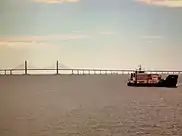
.jpg.webp)
.jpg.webp)
.jpg.webp)
_(closeup).jpg.webp)

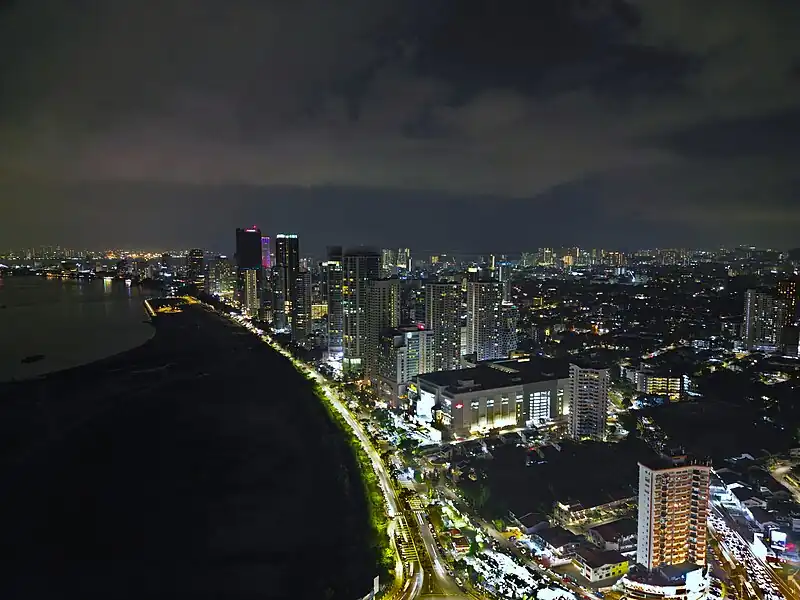

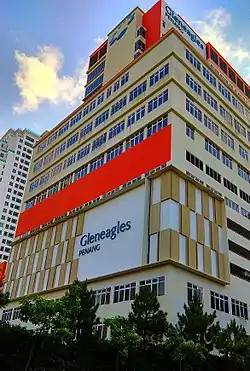

.jpg.webp)
